Article and photos by Joe Sapia
Note: The yard references are to my house in the section of Monroe between Helmetta and Jamesburg in South Middlesex County. My yard is in a Pine Barrens outlier on the Inner Coastal Plain, the soil is loamy, and my neighborhood is on the boundary of Gardening Zones 6b (cooler) and 7a (warmer). Notes and photographs are for the period covered, unless otherwise noted.
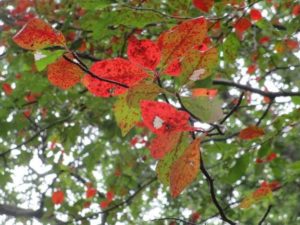 A black gum, “Nyssa sylvattica,” changes color at Cranberry Bog in the Pine Barrens around Helmetta.
A black gum, “Nyssa sylvattica,” changes color at Cranberry Bog in the Pine Barrens around Helmetta.
CHANGING COLORS IN THE PINE BARRENS AROUND HELMETTA: Black gum trees, ““Nyssa sylvattica,” are obvious with their leaves changing colors for the season. “Fall foliage,” meaning the changing colors as colder weather approaches, is a misnomer, because, here, in the Pine Barrens around Helmetta, changing colors are noticeable beginning about July 15 to 31. I look for the peak of the coloring October 13 in wet areas and October 20 in dry areas, but, really, it is impossible to pinpoint a peak. If there is even a peak, because there may not be a uniform turning of colors.
“OPIENKI” MUSHROOMS, PINE BARRENS AROUND HELMETTA: As I drove a paved road through Jamesburg Park today, I saw a car parked at the woods and a woman at the car. She wore yoga pants, a short-sleeve pullover shirt, and sneakers, pants untucked — not really dressed as a woodswoman. So, I took a guess at what she was doing.
Mushrooms? I asked.
She said yes.
What kind, honey mushrooms?, I said.
The woman — Lana, who lived a few miles away from the site — said she did not know the name to tell me. Then, I noticed what sounded to be an Eastern European accent.
“Opienki”? I asked.
Yes, she smiled. How did you know that name?
A grandmother from Poland, I said.
Lana is from the Ukraine. She was picking edible mushrooms of the genus “Armillaria,” known by Polish people as “opienka” singular and “opienki” plural. “Pien” means stump in Polish and these mushrooms grow along the stumps of dead oaks. Hence, they also are known as “stumpies” — and “tan and yellow stumpies” because of their color and, of course, where they are found. But the general public probably would know them best by their common name, “honey mushrooms.”
Lana had bags filled with mushrooms in her car. (See the photos, which she let me take.)
Journalisticly, I am publishing this to inform people. In a neighborly way, I am hesitant to publish this because PICK THE WRONG MUSHROOM AND, AT BEST, YOU WILL GET SICK, AND, AT WORST, YOU WILL DIE.
I am 60-years-old and have been in these woods my whole life, and have heard stories from them going back another 50 or 60 years to when my maternal family settled here, and I will confidently pick ONLY ONE mushroom in the Pine Barrens around Helmetta: opienka. In the Jersey Midlands as a whole, I will confidently pick ONLY TWO: the second one, a morel, which I am familiar with on the Piedmont — say, at such areas as Princeton and Sourland Mountain.
I am “somewhat confident” to pick two more. But I made it to 60 and “somewhat confident” does not cut it. Remember the adage: There are bold mushroom pickers and there are old mushroom pickers. There are no old AND bold mushroom pickers.
If one must pick mushrooms, three bits of advice, even for the experienced picker: One, know how to call emergency responders, telephone 911; two, the telephone number of New Jersey Poison Control, 800-222-1222; and three, save one mushroom, perhaps on your kitchen counter, so doctors know the mushroom one ate.
I said good-bye to Lana, warning her of ticks, which can pass along disease such as Lyme, and chiggers, which will get one itching, beginning about 36 hours after leaving the woods, and scratching like crazy for days. (Me, man who got chiggers a week ago, here, in the Pine Barrens around Helmetta. Me, stupid man because I was not thinking and did not avoid grassy areas.)
(Dedicated to Grandma Annie Poznanski Onda, born 1885 in Poland, died 1972 in the Pine Barrens around Helmetta. And a big thank you to Ralph “Rusty” Richards, woodsman extraordinaire of the Pine Barrens around Helmetta, who continues to be a local woods mentor to me.)
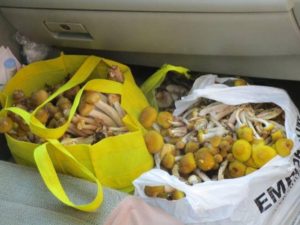
Lana’s “opienki” mushrooms in the Pine Barrens around Helmetta.
ALSO IN THE PINE BARRENS AROUND HELMETTA: Look for fall bloomers, such as asters. Joe Pye weed, “Eutrochium purpureum,” remains blooming – and will do so until about October. Queen Anne’s lace, “Daucus carota,” continues blooming to about November. The seed heads of punks, or cat-tails, genus “Typha,” were fluffing as summer passes.
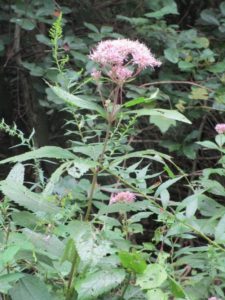
Joe Pye weed in bloom near the Ditch in the Pine Barrens around Helmetta.
CHIGGERS IN THE PINE BARRENS AROUND HELMETTA: I did a brief hike Friday, Sept. 1, and began itching around Sunday morning – chigger bites! Fortunately, I did not get a bad case, a bit of itching here and there on my legs. I first encountered chiggers, here, in about 2004. Some view chiggers as a Southern species moving north; Others will say we already had them up here. I knew of chiggers from hiking in the Pine Barrens down in South Jersey. The bottom line is they itch! So, I will scratch for a few days, then life will go on until the next round of chiggers. (A tip: Avoid grassy areas such as those I walked in on my hike. I just was not thinking.)
MA, GRANDPA, AND THE LOCAL PINE BARRENS: Perhaps I was not thinking of chiggers on Sept. 1 because my mind was elsewhere. Earlier that day, I had mailed in a donation to my church, Holy Trinity Roman Catholic Church in Helmetta, and a request for a Mass to be said in Grandpa Mike Onda’s honor October 11– the 100th anniversary of his death in Helmetta from tuberculosis at 35–years-old. He left a 32-year-old widow, Annie Poznanski Onda, and three children 5-years-old and younger. One of those children was my mother, Sophie Onda Sapia, who was 3 when her father died. Her only memory of her father in later years was of her with him at Shekiro’s Pond in Helmetta. September 1 was the 22nd anniversary of Ma’s death at 81 in 1995. On this anniversary, I visited Shekiro’s Pond.
PESTS IN THE YARD: Neighbor Tom DeRose contacted me on the night of Labor Day, wanting to show me something in his yard. So, in the dark with flashlights, Tom and I were looking into a hole – perhaps big enough to shove in a few golf balls – of yellow jacket wasps. Ugh! They have scared me since I was a kid playing Army in this same neighborhood with Eddie Kasubinski. I pointed down the street at “The Swamp,” where Eddie and I got attacked – not by an opposing army, but by “yellow jacks.” I ran up the street crying. My father heard me, rushed into the backyard, saw the yellow jacks attacking me, grabbed my Army jacket, which had yellow jacks in it, and threw it aside. A number flew out of the jacket. I had got stung twice. Yellow jacks can be aggressive and multiple stingers. So, I advised Tom to stay away from his side yard until the cold weather sets in or spray a pesticide into the hole.
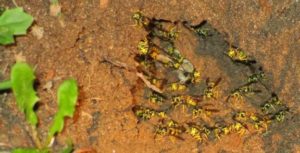
The yellow jacket nest in Tom DeRose and Trisha Miller DeRose’s side yard.
LAURINO FARMS: I was out in Monmouth County and stopped by Laurino Farms on Route 537 (between Laird and Swimming River Roads) in Colts Neck. There, I picked up a favorite of mine, white peaches, along with a jar of cranberry preserves. A shout out to Bobby Laurino, whom I saw briefly – personally, Bobby has patiently answered my gardening questions and he is an inspiration for me growing zinnias this year. And, more importantly, a shout out to Bobby for what he does for feeding the needy, including helping the Soul Kitchen restaurants (www.jbjsoulkitchen.org) in Red Bank and Toms River, founded by rock and roll star Jon Bon Jovi and his wife, Dorothea Bongiovi, who live in Middletown, Monmouth County, to support the needy. For example, Laurino provides space at his farm for Soul Kitchen to grow food organically. Dorothea said, “Bobby is an amazingly generous person, not only with his contribution of land to the Soul Kitchen so we could raise our own vegetables, (but) he is generous with his time, his knowledge, his spirit. I am not sure if all farmers are as optimistic as Bobby, but he has a positive can-do attitude that maybe all farmers need. Farming is an unbelievably difficult life, with many uncontrollable variables: temperature, rain, sun, insects (Bobby does not use pesticides), animals. I have enormous respect for anyone who grows food for others.” (And a shout out to Dorothea, who handles herself with class and humility. Over the summer, Dorothea received a Volunteer Leadership Award in the New Jersey State Governor’s Jefferson Awards for Public Service for her work with Soul Kitchen. “I was very surprised and humbled by the Jefferson award,” Dorothea said.)
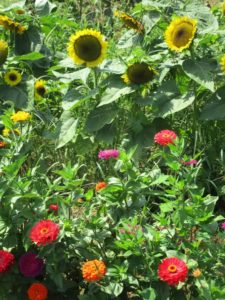
Zinnias and sunflowers at Laurino Farms in Colts Neck, Monmouth County.
DRIVE-BY NATURALIST, “BIDENS” FLOWERS: Although I know the yellow flowers of the genus “Bidens” are adorning unplowed farmland and disturbed areas, it still amazes me when I come across fields of these flowers. I was driving in southern Monroe and came across this batch, next to acres of soybeans.
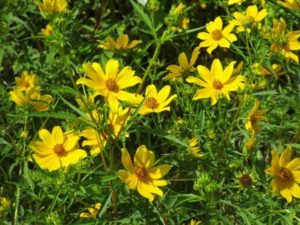
Yellow flowers of the genus “Bidens” in southern Monroe.
IN THE YARD AND GARDEN: The zinnias and Knock Out roses continue to bloom earnestly.
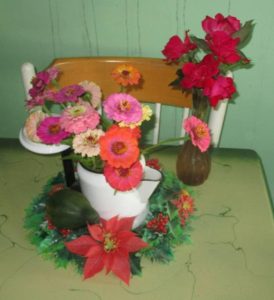
Zinnias, Knock Out roses, and a gourd, all from the my yard or garden, decorate the antique porcelain-top table in my kitchen. One of Ma’s old coffeepots is used as a vase.
MY BELOVED ZINNIAS: While still flowering wonderfully, the zinnias appear to have contracted powdery mildew. So, I will be dealing with this.
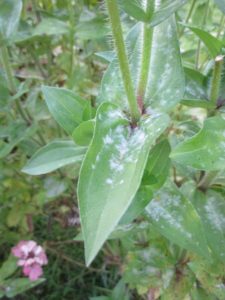
Apparently powdery mildew on the zinnias.
IN THE GARDEN: My summer crop, except for the zinnias, was a disaster. The sweet corn was undeveloped, probably because of too much rain and I should have planted in a bigger block to foster pollination, but it was harvestable and tasty. Too much rain translated into no cucumbers, no cantaloupe. Very few tomatoes, because something ate the tops off the plants.
MECHKOWSKI FARM: Timmy Mechkowski farms in Helmetta. He reported good crops of sweet corn, beets, stringbeans, carrots, broccoli, cabbage, and onions. “Tomatoes were decent until the end, when we starting getting the rain.” Timmy reported a bad year for peppers, potatoes, and blackberries. The Mechkowski farm is one of my favorite places.

Sitting on the front porch of his house, Timmy Mechkowski goes over his planting list.

Timmy Mechkowski’s dog, Abby, probably the most beautiful and most gentle dog I have ever met.
NAVESINK RIVER: The Navesink River drains about 95 square miles in the Red Bank area of Monmouth County. It abuts the hilly geological formation that separates the Inner and Outer Coastal Plains. The river sits on the Outer Coastal Plain side. These photos were taken downstream of the Ocean Bridge from the Middletown side. The bridge connects Middletown and Rumson. The Navesink River is one of my favorite places in the Jersey Midlands.
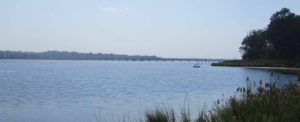
On the Navesink River, looking toward the Oceanic Bridge connecting Rumson, left, and Middletown, right.
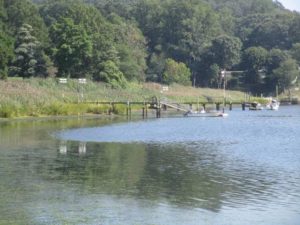
Along the Navesink River.
DRIVE-BY NATURALIST, GREAT BLUE HERON: As I was leaving the Navesink River, I noticed a great blue heron, “Ardea Herodias” – a large bird I am in awe of.
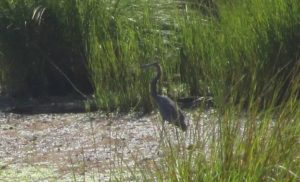
The great blue heron along the Navesink River.
BIG SKY COUNTRY, MONROE TOWNSHIP: As the Jersey Midlands continue to develop, there is more a loss of big sky views. But the area between the Applegarth and Wyckoff’s Mills sections of Monroe is still a holdout. Here, there are wonderful views over soy bean fields and cornfields.
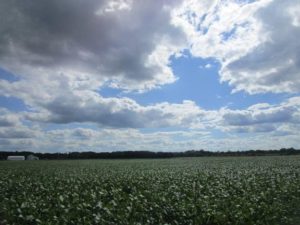
Between Monroe’s Applegarth and Wyckoff’s Mills sections, looking over a soybean field toward Route 33.

Between Monroe’s Applegarth and Wyckoff’s Mills sections, looking toward Cranbury, with corn growing to the right and soybeans to the left.
THE FLIP SIDE OF BAMBI: I have published photographs of beautiful deer in nature. I need to point out the flip side: deer on farmland and in garden. Years ago, I was talking to a farmer who grew corn on the state’s Assunpink Wildlife Management Area in western Monmouth County. The farmer paid no rent, but he had to leave a percentage of his crop to feed wildlife. The way I recall the story: “The problem is,” the farmer said, “the deer don’t know which 75 percent is mine and which 25 percent is theirs.” As Jersey Midlands nature writer John McPhee has written, “Deer, in my opinion, are rats with antlers, roaches with split hooves, denizens of the dark primeval suburbs. Deer intensely suggest New Jersey.”
OCEAN TEMPERATURES: Atlantic Ocean temperatures on the New Jersey coast were in the range of about 69 to 72 degrees during the weekend of September 9-10.
SUNRISE/SUNSET: For September 10, Sunday, to September 16, Saturday, the sun will rise about 6:35 to 6:40 a.m. and set about 7:10. For September 17, Sunday, to September 23, Saturday, the sun will rise about 6:40 to 6:45 and set about 6:55 to 7:05. The fall equinox of nearly equal daylight and sunlight is September 22, Friday.
THE NIGHT SKY: This week, in the pre-sunrise sky, I saw the constellation Orion for the first time this season – Colder weather is coming with the winter constellations. The moon is waning after the September 6 full moon. The new moon is September 20, Wednesday. The next full moon is the Full Harvest Moon October 5, Thursday.
WEATHER: The National Weather Service forecasting station for the area is at http://www.weather.gov/phi/.
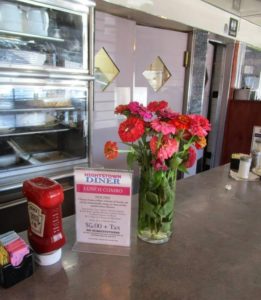
Joey’s zinnias at the Hightstown Diner, in Hightstown, Mercer County.
Joe Sapia, 60, is a lifelong Monroe resident. He is a Pine Barrens naturalist and an organic vegetable-fruit gardener. He gardens the same backyard plot as did his Italian-American father, Joe Sr., and his Polish-immigrant, maternal grandmother, Annie Poznanski Onda. Both are inspirations for his food gardening. Joe is active with the Rutgers University Master Gardeners/Middlesex County program. He draws inspiration on the Pine Barrens around Helmetta from his mother, Sophie Onda Sapia, who lived her whole life in these Pines, and his Grandma Annie. Joe’s work also is at @JosephSapia on Twitter.com, along with Facebook.com on the Jersey Midlands page.
Article and photos by Joe Sapia
Note: The yard references are to my house in the section of Monroe between Helmetta and Jamesburg in South Middlesex County. My yard is in a Pine Barrens outlier on the Inner Coastal Plain, the soil is loamy, and my neighborhood is on the boundary of Gardening Zones 6b (cooler) and 7a (warmer). Notes and photographs are for the period covered, unless otherwise noted.
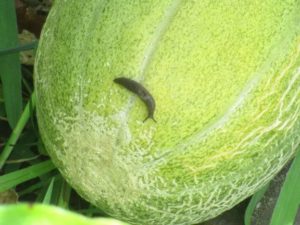
This photograph – that of a slug on a cantaloupe — basically sums up my garden’s summer fruit and vegetable crop. Slugs like moisture. And it was just a wet season.
GARDEN VOICES, NO.1: “It has simply been too wet for most things,” said Bob Eriksen, a retired biologist with the state Department of Environmental Protection who gardens in Warren County, just outside of the Jersey Midlands. “I have had groundhog issues in our garden, as well as deer. The deer are early — when the mulberries are hitting the ground, they spend time poking around our yard nibbling on everything. The groundhogs have been a major issue, eating everything from tomatoes and peppers to petunias. I have removed eight, so far, and believe there are still at least two more. I did not trap any last summer, but the summer before I caught nine.”
IN THE GARDEN: Aside from the zinnias and Knock Out roses, both of which continue to produce nicely, I pretty much have given up on the rest of the summer crop. Not one cucumber! And I fear not one cantaloupe will ripen properly. But the fall crop of carrots and lettuce, planted in early August, are coming up nicely.
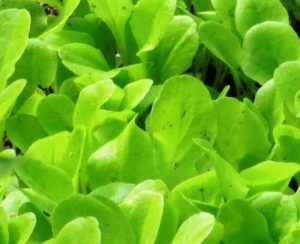
Here comes the fall lettuce crop.
GARDEN VOICES, NO. 2: Paul Migut, a childhood friend and one of my gardening mentors, checked in from South River, Middlesex County. Paul, who is in his early 60s, has been food gardening since childhood: “I’d say this wasn’t the best of year for the vegetable garden. I’d say 3 out of 5.
Bush beans producing about 20 percent of previous month. Some plants drying up, branches showing signs of ‘old age’ (brown, brittle). Pickles still producing, but much slower, and also appear to be drying despite watering at 6:30am. Zucchini, a total waste as borers devoured the stalks.
Eggplants producing, but not as plump as prior years. Rutgers tomatoes small, (good color and that Jersey flavor!). Yellow (acid-free) producing fairly well, though appear a bit delicate with signs of spots, imperfections, but rather juicy. Radishes done. And the ‘mistake’ purchase of turnip (Purple Top White Globe, ‘Brassica rapa’) are still leafy, bushy, and still getting bigger — some over 4 to 5 inches diameter. Pulled more weeds than crops yesterday! Now to the house- rotate use of de-humidifier water between hydrangea in front of house and to refill backyard birdbath.” Paul is a great food gardener, making a not-so-good food garden year still a good year.

Circa late 1960s, Monroe Township – Paul Migut with an 8-horsepower roto-tiller at the huge garden of his uncle, Stanley “Pon” Ceslowski.
AROUND THE YARD: I was harvesting zinnia in the backyard garden when a large shadow passed over the backyard. I looked up and only a few yards away flew two turkey vultures, “Cathartes aura.” Usually, I see them soaring, riding the currents, rather than being nearby. I did not smell any dead animal for them to scavenge. So, perhaps they were perched nearby and I startled them.
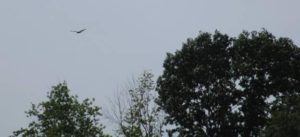
This turkey vulture flew off while I was in the backyard.
CATBIRDS AND CAT: I was doing some outside painting when a ruckus interrupted me. About four catbirds, “Dumetella carolinensis,” converged in the shrubbery behind me, next to the street. Underneath the hedges was the neighborhood cat, feasting on what was once part of the catbird clan.
DRIVE-BY NATURALIST: I was driving across the Swimming River Reservoir on the boundary of Holmdel and Colts Neck in Monmouth County and noticed two great egrets, “Ardea alba,” so I stopped and shot photos of one with Canada geese, “Branta canadensis.”
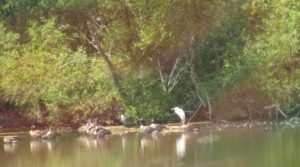
A great egret and Canada geese on the Swimming River Reservoir in Monmouth County.
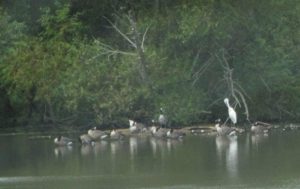
Another view of the great egret and Canada geese on the Swimming River Reservoir.
SEA BRIGHT BEACH: The Atlantic Ocean had a bit of a chop on the afternoon of Tuesday, August 29, at Sea Bright, Monmouth County, the surf tussled by the wind — sustained at about 10 to 13 knots per hour (a “gentle breeze” to “moderate breeze”) and gusts up to 14 to 19 KPH (“moderate breeze” to “fresh breeze”) about 3:30 to 4 o’clock, all out of the East Northeast, as recorded at nearby Sandy Hook. (Honestly, I thought the wind was blowing harder at Sea Bright.) Flags were extended, the surf rough, and foam, created by an agitated ocean, covered the surf line. Plus, it was raining. …But it was OK, that is what nature is about. And I had the beach to myself!
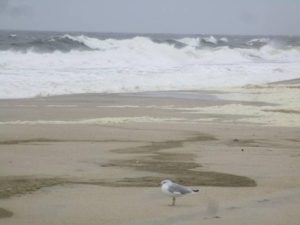
On this day at the beach in Sea Bright, Monmouth County, whitecaps were on the Atlantic Ocean, the surf churned, and the agitated ocean produced foam covering the surf line. It was kind of a day for the birds – or beach naturalists.
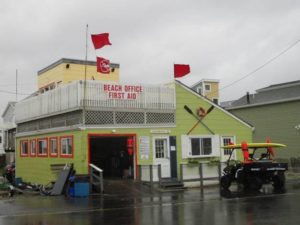
Flags at the Sea Bright Ocean Rescue Headquarters show the force of the wind.
SEPTEMBER AT THE SHORE: The traditional Jersey Shore summer season is the Memorial Day Weekend to the Labor Day Weekend. So, Labor Day Monday, September 4, would mean it is all over. Wrong! Remember the Shore secret, September is the best month at the Shore – less people, warm air and Atlantic Ocean temperatures, soft sunlight. But be extra careful if going into the ocean when lifeguards are not on duty.

2013, September, at the Atlantic Ocean in Asbury Park.
YELLOW FLOWERS IN THE FIELDS: The “Bidens” genus flowers are blooming nicely on unused farmland and disturbed areas. I vaguely remember hearing a story this yellow flower is not native to New Jersey, first being discovered in the state along railroad tracks at Camp Kilmer near New Brunswick in the post-World War II or Korean War years, suggesting it was transported from its native southern United States via railroad. I am going to take a guess and identify the species as “aristosa.” (But this historical and botanical information would have to be verified.) Basically, it is a weed — although a colorful one that brightens fields this time of year.
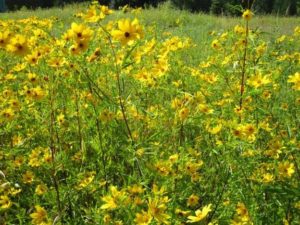
“Bidens” wildflower growing in South Brunswick, Middlesex County.
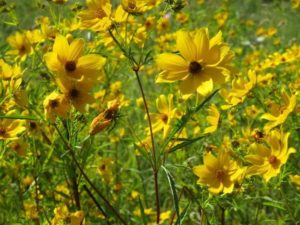
More of the “Bidens” wildflower in South Brunswick, Middlesex County.
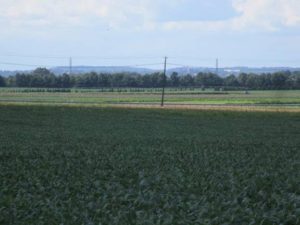
Where the generally flat Coastal Plain meets the rolling hills of the Piedmont — In the foreground is a soybean field on the boundary of Cranbury and Plainsboro in Middlesex County on the Coastal Plain, or more specifically the Inner Coastal Plain. In the distance haze are the rolling hills of Princeton, Mercer County, on the Piedmont. The Jersey Midlands are filled with stories of geology, flora, fauna, and, especially if we turn off outside lighting, the Night Sky.
COASTAL PLAIN BODIES OF WATER: Between the soybean field and the hilly ground in the previous photograph is a 23-acre pond in Plainsboro. The name on the sign, “Mill Pond Park,” says a lot. Its name suggests the pond was built, by damming Cranbury Brook, to form a power source for a mill. Most, if not all, bodies of water on the generally flat Coastal Plain are human-made.
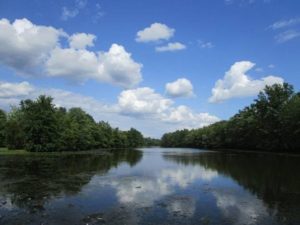
Plainsboro’s Mill Pond
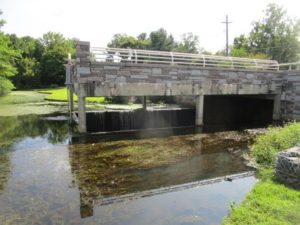
The dam that holds back Cranbury Brook to form Plainsboro’s Mill Pond.
A TALE OF TWO DEER: As I drove through Thompson Park in Monroe, I noticed a white-tail deer, “Odocoileus virginianus,” buck. He had a beautiful 10-point, velvet-covered rack. He was not free. Instead, he was confined behind a fence as part of the park zoo. Later that day, I saw another beautiful buck, this one on a section of Sourland Mountain in Montgomery, Somerset County. He roamed freely in a rural area of woods and farmland. But how free is “free”? Assuming the status of the two deer does not change, the zoo buck will be safe during hunting season, but the Sourland Mountain deer may wind up as someone’s meal or trophy.
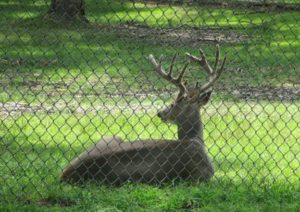
The Thompson Park Buck
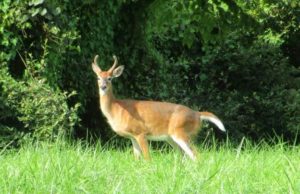
The Sourland Mountain buck.
FOR LAWN LOVERS, BLEGGGGGHHHH!: As you probably know, I dislike trophy lawns – basically, non-native wastelands filled with pollutants. Better to go green – go organic, go with native plants instead of a lawn, create high-grass wildlife patches, grow vegetables, or plant annual flowers that attract pollinators. But if you must…. Now is the correct time to seed lawns – as early in September as possible, not later than mid-September. This time of year provides for good seed growth, while competitive weeds are no longer growing. See the Rutgers University Cooperative Extension Service “Seeding Your Lawn” fact sheet, https://njaes.rutgers.edu/pubs/fs584/.
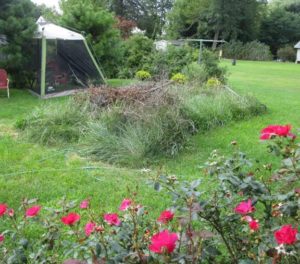
A wildlife patch in my neatly kept, but un-trophy-like, lawn.
GARDEN VOICES, NO. 3: Priscilla “Peppy” Bath, who gardens in Hamilton, Mercer County, knows about my quest to eliminate lawn in favor of garden. She checked in from vacation in Germany’s Black Forest. “I took a walk this morning and the house across from my hotel has no grass at all, just a beautifully maintained garden. It has flowers and vegetables, no weeds. Knock Out roses, cosmos, mountain pink, lots of lettuce, green beans, tomatoes, zucchini, and bare spaces where other already-harvested vegetables were. Perhaps this is what you are striving for.”
LEECHES: Sophie Onda Sapia used to tell me about leeches when she was a kid in the Pine Barrens Around Helmetta, where she lived all her 81 years, from 1913 to 1995. Ma said sometime one or more would latch onto one when swimming in the local waters. I have been around these waters all my 60 years – blessed to still walk afield where my maternal family has walked more than 100 years, despite New Jersey urbanization – and never recall pulling a leech off me. But I saw some chatter the other day on the “Jersey Pine Barrens” Facebook.com page about the “unusual amount” of leeches encountered, this year. Thoughts?
GRIGGSTOWN FARM: I stopped at Griggstown Farm near the Delaware and Raritan Canal in Franklin, Somerset County, and bought some goods – sweet corn, tomato, etc. Of course, I shot photos. More information, https://griggstownfarm.com/.
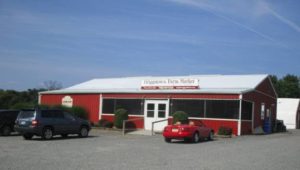
The market at Griggstown Farm in Franklin, Somerset County.
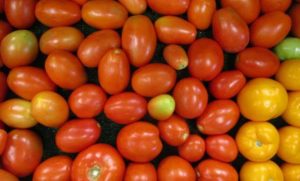
Tomatoes at Griggstown Farm.

Griggstown Farm’s cookbook library.
OCEAN TEMPERATURES: Atlantic Ocean temperatures on the New Jersey coast were in the range of about 72 to 74 degrees Thursday, August 31.

A lifeguard boat at Sea Bright, Monmouth County.
SUNRISE/SUNSET: For September 3, Sunday, to September 9, Saturday, the sun will rise about 6:30 a.m. and set about 7:20 p.m. For September 10, Sunday, to September 16, Saturday, the sun will rise about 6:35 to 6:40 a.m. and set about 7:10.
THE NIGHT SKY: The Full Corn Moon is on the Sept. 5-6, Tuesday-Wednesday, overnight.
WEATHER: The National Weather Service forecasting station for the area is at http://www.weather.gov/phi/.
UPCOMING: September 9 and 10, Saturday and Sunday, 10 a.m. to 5 p.m., the state Department of Environmental Protection’s Wild Outdoor Expo at the Colliers Mills Wildlife Management Area, Jackson, Ocean County, WildOutdoorExpo.com.

The zinnias from the garden keep on giving. Here, at a friend’s house.
Joe Sapia, 60, is a lifelong Monroe resident. He is a Pine Barrens naturalist and an organic vegetable-fruit gardener. He gardens the same backyard plot as did his Italian-American father, Joe Sr., and his Polish-immigrant, maternal grandmother, Annie Poznanski Onda. Both are inspirations for his food gardening. Joe is active with the Rutgers University Master Gardeners/Middlesex County program. He draws inspiration on the Pine Barrens around Helmetta from his mother, Sophie Onda Sapia, who lived her whole life in these Pines, and his Grandma Annie. Joe’s work also is at @JosephSapia on Twitter.com, along with Facebook.com on the Jersey Midlands page.
Article and photos by Joe Sapia
Note: The yard references are to my house in the section of Monroe between Helmetta and Jamesburg in South Middlesex County. My yard is in a Pine Barrens outlier on the Inner Coastal Plain, the soil is loamy, and my neighborhood is on the boundary of Gardening Zones 6b (cooler) and 7a (warmer). Notes and photographs are for the period covered, unless otherwise noted.
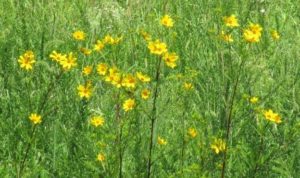
Flowers of the “Bidens” genus growing along South River Road/Route 535 in Cranbury, Middlesex County.
YELLOW FLOWERS IN FIELDS: This time of year, it is common to see a yellow flower of the “Bidens” genus on overgrown farmland. Over the last dozen years, I have seen them begin blooming from about August 20 to August 25. This year, I saw the first blooming August 24, Thursday – in this case in Cranbury, Middlesex County.
IN THE GARDEN, SWEET CORN: I wrapped up the sweet corn harvest, which produced a poor, but usable, crop. The ears developed only partially, basically one half with kernels, one half without. The poor development may be attributable to poor pollination. Corn should be planted in blocks so its pollen can fly back and forth to the plants in the wind. If pollination was the problem, I see two major reasons – one, my corn block was probably too small, in part thanks to a house re-modeling project that fouled up my garden area and by planting a bigger garden this year, I lost area to plant corn in larger blocks and, two, the wet weather may have kept down the spread of pollen. Because I like eating the corn raw off the cob or, if cooked, then sliced off with a knife, the poor development did not affect me in eating what I could harvest. But the quantity of the harvest also was terrible, meaning I had less corn to eat.
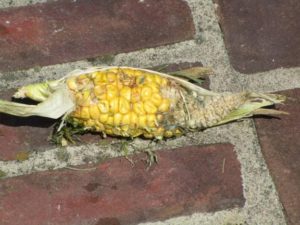
A half-developed ear of corn from the garden.
ELSEWHERE IN THE GARDEN: The early cool-weather harvest was so-so – great pickings of lettuce, carrots having a low yield, and peas bombing out. The jury is still out on the summer crop – I gave up on growing tomato plants from the seeds I planted and bought plants, only to have something eat the tops off of them; as I said, the corn generally bombed; the cucumbers bombed, probably because of too much rain, and I still have hope for mushmelon. My first-time planting of zinnias has saved the summer crop.
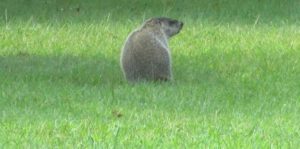
This may be the culprit that is eating the plants in my garden – a ground hog, “Marmota monax.” It was photographed in my next-door neighbor’s yard.
GRATEFUL FOR THE ZINNIAS: If it was not for my zinnias, planted in the food garden to attract pollinators, I would not have much of a summer harvest. Not only do the zinnias attract pollinators, but they are nice to look at – and give away.
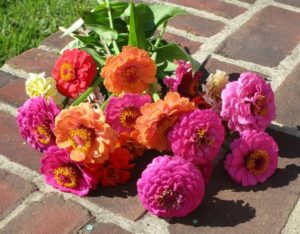
Zinnias as a gift for the eye doctor’s office.
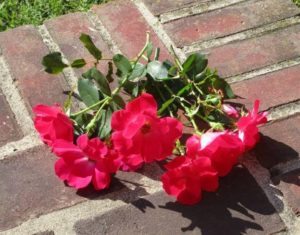
Add some Knock Out roses for the eye doctor’s office.
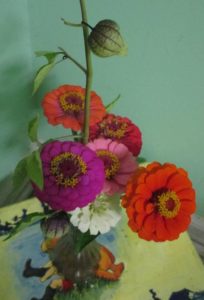
Zinnias, along with tomatillos, for the kitchen table.
ZINNIAS AND BUTTERFLIES: My morning zone-out time, just after getting up, would be watching the birds at the feeder. This summer, however, I gave up the feeder – saving money on top-quality (and costly) feed of corn kernels and putting the birds to work harvesting insects in the yard. So, until cool weather comes and the feeder goes back up, my only meditative exercise was watering the garden. Now, I found something new – watching the butterflies in the zinnia. I have discovered if I just go about my business of walking through the zinnia patch or harvesting zinnia, the butterflies just go about their business. They do not fly off by my intrusion. The butterflies and I have become friends. I am becoming one with the zinnia patch.
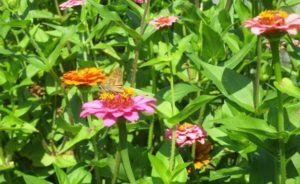
I believe the butterfly on the zinnia is a sachem, “Atalopedes campestris.”
DRAGONFLIES AROUND THE YARD: My yard seems to have hosted a lot of dragonflies this summer. Now, I have to learn to identify them.
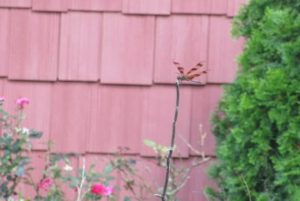
A dragonfly in my backyard.
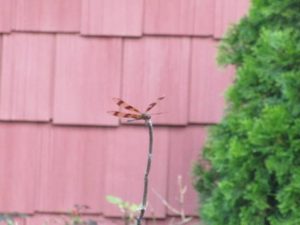
Another view of the dragonfly in my backyard.
KEYPORT HARBOR: On a free-lance writing assignment, I had to go out to the Raritan Bayshore of Monmouth County, so I stopped by Keyport harbor to crank off some photographs.
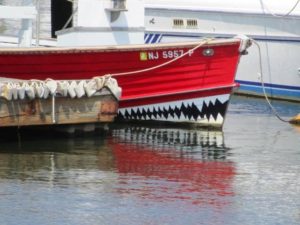 Jaws at Keyport Harbor, Monmouth County
Jaws at Keyport Harbor, Monmouth County

From Keyport harbor, looking to Staten Island, New York City, in the hazy distance.
THE ECLIPSE OF THE SUN: My plan was to stay inside during the August 21, Monday, solar eclipse, so as not to be tempted to look at the sun and possibly ruin my eyesight. Well, I was working at my desk during the eclipse, realized I left my camera in my Jeep, and went outside to retrieve it. I grabbed a kitchen strainer and, with my back to the sun, let the sunlight shine through the holes of the strainer onto my back porch. It was pretty cool, watching dozens of shadows of the sun in eclipse. With about 75 percent of the sun covered around 2:45 p.m., sun shadows were obvious, but the sunlight had the soft glow of dusk. Insects remained calling and a butterfly flew by.

The eclipse through the strainer.
BLUEBIRD SKY: While out in the yard August 24, Thursday, I noticed how clear the sky was – a “bluebird sky.” Jet airplanes could be clearly seen, with that I-almost-can-touch-them look. That means there was little moisture in the air – a dew point of only 52.
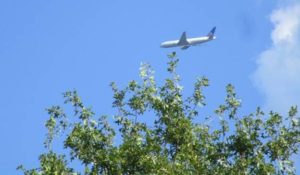
With low moisture in the air, this United Airlines flight, headed to Newark Liberty International Airport from Tel Aviv, Israel, looked very close to my backyard. It was actually flying at an estimated 3,000 feet.

Another view of the “bluebird sky” from my backyard.
DEW POINT: My go-to science guy – Joey Slezak of Helmetta, who has a bachelor’s degree in meteorology and is now working on his master’s in meteorology, both from Rutgers University – tells me dew point, not the humidity reading, is the real gauge of moisture around us and how we feel in it. Here, according to www.fredericksburg.com in Virginia, is how we feel at these dew points — under 55, pleasant; 56 to 60, comfortable; 61 to 65, getting sticky; 66 to 70, uncomfortable; 71 to 75, oppressive; more than 75, miserable.
BOBWHITE QUAIL IN NEW JERSEY: A Philadelphia Inquirer article about restoring BobWhite quail, “Colinus virginianus,” to the Pine Barrens, http://www.philly.com/philly/columnists/kevin_riordan/bringing-back-a-bird-that-once-made-a-signature-sound-of-the-pine-barrens-20170822.html. See Cornell University’s All About Birds website for more on the BobWhite, https://www.allaboutbirds.org/guide/Northern_Bobwhite/id.
CRICKETS IN MY CELLAR: As an only child, I inherited the house I grew up in and which my parents owned for almost four years before I was born in 1956. I never remember crickets in the cellar when I was a kid. But after I took over the house 15 years ago, I noticed a cricket invasion from about August until the fall weather set in. Now, a cricket-chirping cacophony is pleasant, but one or two crickets in the wee hours while one is trying to sleep is AN-NOY-ING – and it turns me from Dr. Naturalist to Mr. Killer, Serial Killer if there is more than one of these little nuisances calling away. But I just had a $38,000 re-modeling of my house, including new siding and insulation. The best $38,000 I could spend on eradicating crickets from the cellar. So far, and it is already late August, only six crickets – none of which are with us anymore. I mean, if a cricket wants to live outside and chirp away, I get it. But if a cricket wants to invade my cellar and rub those little ugly legs together, NO. (OK, OK, OK, now that I feel sort of bad about cricket killing, I will tell you about Revenge of the Crickets. A few years ago, I saw a cricket in the cellar. And I had had it! So, I picked up the pail I used to empty de-humidifier water into and SMASHED the cricket. I poured the de-humidifier water into the bucket — and the water spilled onto the cellar floor. Yes, I had cracked the bucket when I obliterated the cricket. I never learn – whenever I act surly, I pay for it.)
(Sorry, no photo of a dead cricket.)
OCEAN TEMPERATURES: Atlantic Ocean temperatures on the New Jersey coast were in the range of about 74 to 77 degrees.
SUNRISE/SUNSET: For August 27, Sunday, to September 2, Saturday, the sun will rise about 6:20 to 6:25 a.m. and set about 7:30 p.m.
WEATHER: The National Weather Service forecasting station for the area is at http://www.weather.gov/phi/.
UPCOMING: September 9 and 10, Saturday and Sunday, 10 a.m. to 5 p.m., the state Department of Environmental Protection’s Wild Outdoor Expo at the Colliers Mills Wildlife Management Area, Jackson, Ocean County, WildOutdoorExpo.com.
DOES ANYBODY ELSE…?: …Go to a fast-food restaurant and instead of tossing in the garbage all the paper packaging and so on, take it home for recycling?

Sailboats at Keyport harbor.
Joe Sapia, 60, is a lifelong Monroe resident. He is a Pine Barrens naturalist and an organic vegetable-fruit gardener. He gardens the same backyard plot as did his Italian-American father, Joe Sr., and his Polish-immigrant, maternal grandmother, Annie Poznanski Onda. Both are inspirations for his food gardening. Joe is active with the Rutgers University Master Gardeners/Middlesex County program. He draws inspiration on the Pine Barrens around Helmetta from his mother, Sophie Onda Sapia, who lived her whole life in these Pines, and his Grandma Annie. Joe’s work also is at @JosephSapia on Twitter.com, along with Facebook.com on the Jersey Midlands page. Copyright 2017 by Joseph Sapia
Article and photos by Joe Sapia
Note: The yard references are to my house in the section of Monroe between Helmetta and Jamesburg in South Middlesex County. My yard is in a Pine Barrens outlier on the Inner Coastal Plain, the soil is loamy, and my neighborhood is on the boundary of Gardening Zones 6b (cooler) and 7a (warmer). Notes and photographs are for the period covered, unless otherwise noted.
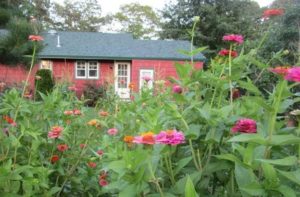
Looking across my backyard garden to the Knock Out roses and the house.
IN THE GARDEN: I began harvesting sweet corn – it tastes so good! I continued harvesting zinnia, mostly giving them away. Because zinnia are so beautiful, make nice bouquet gifts, and are so attractive to pollinators, I plan to really expand on growing them next year, taking over what is now a waste of lawn. I finished planting seeds for fall crops of beets, carrots, lettuce, and peas. Including early season, summer and fall crops, my garden is about 450 row feet. I began keeping a record of my harvest, so I have an idea how productive the garden actually is. Next year, I plan to keep the record from Day 1 harvest to Last Day harvest.
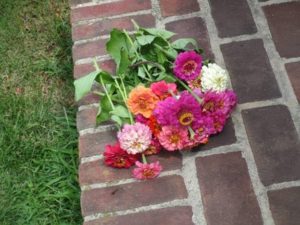
A zinnia bouquet heading to friends at my Sunday lunch stop, the Hightstown Diner.
A BAD GARDENING YEAR: I thought my garden was bombing out because of my lack of skills, but I continue to get reports of it not being a productive vegetable year. Paul Migut, a childhood friend and a gardening mentor of mine, checked in from South River, Middlesex County: “Agree, not one of the best garden years, here either.” Jack Mangano of Helmetta told me his family’s plot is not doing as good as it should. The weather has been fickle, one day monsooning, another day sunny and in the 90s – seemingly more fickle than a normal Jersey hot and humid summer with thunderstorms in the afternoon. I found a split cucumber, which, I suspect, was a victim of the rain – the rain forcing it to grow faster than it was able to maintain, resulting in it finally bursting.
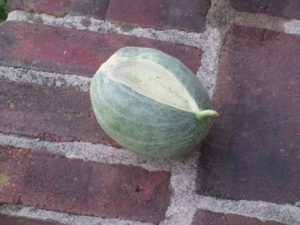
A split and ill-forming cucumber, an apparent victim of too much rain.
GARDENING TALK: Paul Migut reported on his garden: “Bush beans producing the best. Cucumbers growing well (made second batch of dill pickles in my grandmother’s 100-year-old old crock). Rutgers tomatoes getting bigger, but still green. Yellow (acid-free) almost ready to pick. Eggplants, too small to pick. Zucchini started out with a bang, until worm/borer devoured base of plant. By accident, I purchased a packet of turnip seeds, never grew these before, but wow- growing very well!”
ELSEWHERE AROUND THE YARD: I took off from feeding the birds this summer, letting them, instead, eat insects in the yard and serve as natural pesticides. So, I have not kept the eye I normally do on birds, mesmerized by them at the feeder. However, I did notice a bright yellow and black (male) Eastern goldfinch, “Spinus tristis”; a bright red (male) cardinal, “Cardinalis cardinalis”; and a favorite, a catbird, “Dumetella carolinensis” – the catbirds that keep me company in garden and afield. The toads are around, presumably helping control insects. I helped a toad out of a deep well of cellar window that was recently installed. I place a branch in the well; If a toad goes in, hopefully it can crawl out on the branch – because by the time I notice it, it may be too late. Of course, the friendly rabbits are around – letting me get close and probably eating up the garden. And the Knock Out roses, in their second bloom of the season, are getting better and better.
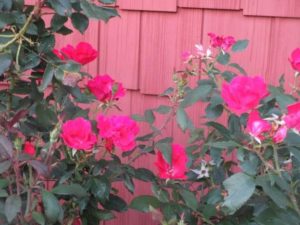
Knock Out roses are blooming beautifully in their second bloom of the season.
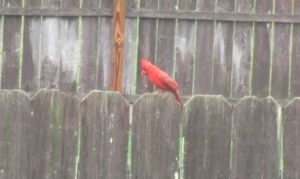
A male cardinal perched by the garden. A male, because it is bright red. The female is a dull brown.
ATTRACTING POLLINATORS, ZINNIA: While I love the beauty and no-fuss growing of zinnias, my real goal for planting them this year was to attract pollinators. This week, pollinators were around:

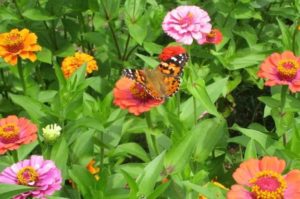
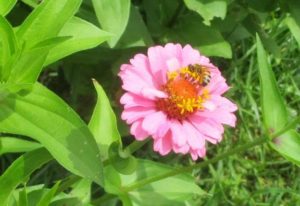
PERSEID METEOR SHOWER: The forecasted weather is not looking good, but take a chance and look up into the night sky on the overnights of August 11-12, Friday-Saturday, or August 12-13, Saturday-Sunday, the peak of the annual Perseid Meteor Shower. If there is a clear sky, an estimated 40 to 50 “shooting stars” will be visible per hour. The Earth will continue passing through Comet Swift-Tuttle’s path until August 24. See www.space.com/32868-perseid-meteor-shower-guide.html.
THE DRIVE-BY NATURALIST, ROADKILL: I was driving south on Route 539 in East Windsor, Mercer County, heading for the Assunpink Wildlife Management Area, when I came across an interesting sight -– vultures, both turkey, “Cathartes aura”, and black, “Coragyps atratus,” eating a roadkill deer, “Odocoileus virginianus.” It was an interesting study in nature, the death of one animal providing life-support to other wildlife. But it also was an interesting interaction between wildlife and humans – basically, traffic had to avoid the vultures, rather than the vultures making a serious attempt to avoid traffic. What did I take away from this scene? The importance of us helping living wildlife by moving dead wildlife off the roadway, because other birds may not be so lucky squaring off against traffic at a roadkill. A live bird could end up as roadkill.
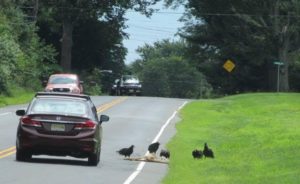
Notice how traffic has to move to avoid the vultures, while the vultures generally were carefree.
DRIVE-BY NATURALIST, NO. 2 – TURKEY VULTURES VS. BLACK VULTURES: Turkey vulture, red head, long tail. Black vulture, black head, short tail. (Note: I do not recall seeing a black vulture locally until probably the 1990s. They are a southern species that has moved northward.)
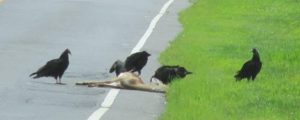
Turkey vulture, far left, with a red head and longer tail. Black vulture, far right, with short tail and black head.
CONNECTING WILDLIFE HABITAT: The state Department of Environmental Protection’s Endangered and Nongame Species Program has been working on a project, CHANJ, or Connecting Habitat Across New Jersey, which is aimed at creating wildlife habitat connectivity, since about 2012. The plan is to make a public push in 2018. CHANJ is looking to protecting habitat and connecting habitat through such things as land purchase, management of land, and safe wildlife passage at roadways. Roadway mitigation could include using culverts and bridges to have a safe pathway for wildlife to cross roads. The idea is have connectivity using core areas, which could be as little as 200 acres to as big as state regions such as the Highlands of North Jersey and, locally, the Pine Barrens. Core is “an area with high ecological integrity,” said Gretchen Fowles, a CHANJ biologist. “That’s a fancy way of saying it has little human influence,” she said. In Monmouth County, for example, beside the Pine Barrens as a region, CHANJ looks at cores as such places as the Navesink River, Manasquan River Reservoir, Shark River, Allaire State Park, the Turkey Swamp state- and county-owned properties, Monmouth Battlefield State Park, and Assunpink Wildlife Management Area. Then, the idea is to connect such areas as forest, field, freshwater wetlands, and coastal maritime habitats. “This might be kind of a last chance to keep areas protected and intact,” Fowles said. The CHANJ website is at http://www.state.nj.us/dep/fgw/ensp/chanj.htm. Also, a CHANJ video is at https://www.youtube.com/watch?v=6UbBcTUfz1U.
MUSHROOMS: Remember the adage, “There are old mushroom pickers. There are bold mushroom pickers. There are NO old AND bold mushroom pickers.” Me, 60-years-old, lifelong Jersey Midlands, from a maternal Polish-Slovak family of pickers going back here more than 100 years and I will comfortably pick only 2 mushroom species: honey (or “opienki,” as my Polski side calls them), genus “Armillaria,” and morels genus “Morchella.” My confidence in only those 2 comes from being taught by two smart, non-bold pickers. Because this time of year is popular for wild mushrooms: http://www.philly.com/philly/health/n-j-mushroom-poisonings-spike-some-potentially-life-threatening-20170808.html
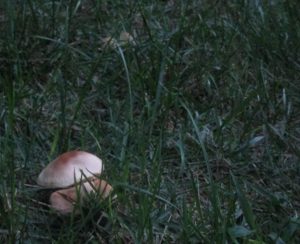
Inedible mushrooms in my yard.
“FALL” FOLIAGE: In the Pine Barrens around Helmetta, the beginning of the “fall” foliage usually is obvious in swamps beginning about July 15 to July 31. So, no surprise I have seen a few examples.
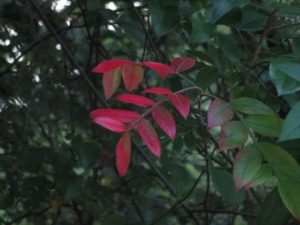
Changing colors in the Helmetta Pond wetlands.
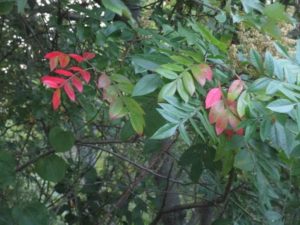
Another view of the changing colors in the Helmetta wetlands.
OCEAN TEMPERATURES: Atlantic Ocean temperatures on the New Jersey coast were in the range of about 76 to 78 degrees Thursday, August 10.
UPCOMING COUNTY FAIRS: Middlesex County Fair concludes August 13, Sunday, in East Brunswick, http://middlesexcountyfair.com/. Hunterdon County 4-H and Agricultural Fair, August 23, Wednesday, to August 27, Sunday, http://www.hunterdoncountyfair.com/.
OTHER UPCOMING: August 21, Monday, solar eclipse. September 9 and 10, Saturday and Sunday, 10 a.m. to 5 p.m., the state Department of Environmental Protection’s Wild Outdoor Expo at the Colliers Mills Wildlife Management Area, Jackson, Ocean County, WildOutdoorExpo.com.
SUNRISE/SUNSET: For Aug. 13, Sunday, to August 19, Saturday, the sun will rise about 6:05 to 6:15 a.m. and set about 7:50 p.m. to 7:55 p.m. For August 20, Sunday, to August 26, Saturday, the sun will rise about 6:15 to 6:20 a.m. and set about 7:40 to 7:50 p.m.
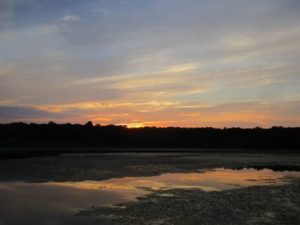
Sunset at Helmetta Pond.
WEATHER: The National Weather Service forecasting station for the area is at http://www.weather.gov/phi/.
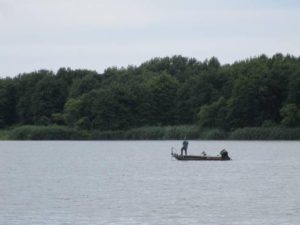
Assunpink at the Assunpink Wildlife Management Area, here in Monmouth County
Joe Sapia, 60, is a lifelong Monroe resident. He is a Pine Barrens naturalist and an organic vegetable-fruit gardener. He gardens the same backyard plot as did his Italian-American father, Joe Sr., and his Polish-immigrant, maternal grandmother, Annie Poznanski Onda. Both are inspirations for his food gardening. Joe is active with the Rutgers University Master Gardeners/Middlesex County program. He draws inspiration on the Pine Barrens around Helmetta from his mother, Sophie Onda Sapia, who lived her whole life in these Pines, and his Grandma Annie.
Joe’s work also is at @JosephSapia on Twitter.com, along with Facebook.com on the Jersey Midlands page.
Article and photos by Joe Sapia
Note: The yard references are to my house in the section of Monroe between Helmetta and Jamesburg in South Middlesex County. My yard is in a Pine Barrens outlier on the Inner Coastal Plain, the soil is loamy, and my neighborhood is on the boundary of Gardening Zones 6b (cooler) and 7a (warmer). Notes and photographs are for the period covered, unless otherwise noted.
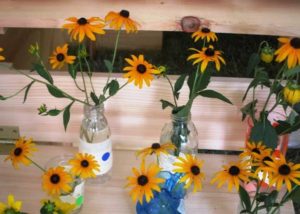
Flowers on display at the Monmouth County Fair, which runs through Sunday, July 30, in Freehold Township.
THE DRIVE-BY NATURALIST, FLICKER: I aim to check the family gravesites once a month, with one of my visits to Saint James Cemetery in Monroe. There, I observed a bird I normally only get a glimpse of, flying off when spooked, the northern flicker, “Colaptes auratus” – in Greek, the genus name referring to “peck” because the flicker is a woodpecker and the species name referring to its “golden” underwing, according to the Texas Parks and Wildlife website. The flicker, whose body is generally tan with black speckles, is easily identifiable when it flies off because of its white rump. The flicker is a year-round resident.
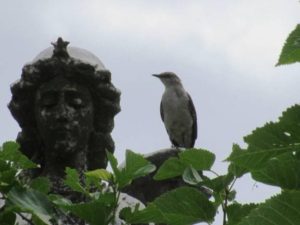
A flicker at St. James Cemetery, Monroe.
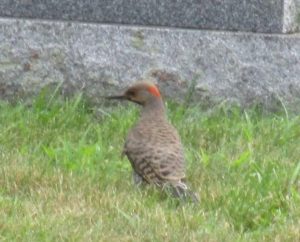
The Saint James Cemetery flicker.
IN THE GARDEN: I picked multi-color carrots and green tomatoes for a salad. A true tomato crop will be iffy because some animal is snipping the tops of the plants. Sweet corn should be ready for picking soon (if the deer or raccoons do not get to it), although I noticed some yellowing of the leaves, probably attributable to the recent wet conditions. The rains apparently caused the splitting of a cantaloupe – basically, the rain forcing the fruit to develop more quickly than it is capable. So, I am backing off on watering at least the cantaloupe. The missing cucumbers are no longer missing; they are fruiting. I thought the tomatillos – which I did not plant and do not know where they came from – were ready for harvest, but they are still developing.
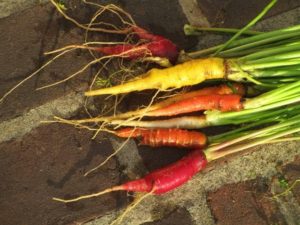
Pick green tomatoes and multi-color carrots from the garden, add balsamic vinaigrette dressing, and, voila, Joey’s Garden Garden Salad.
MY GARDEN WATERING OBSESSION: My two water barrels are pretty full, meaning I have about 50 gallons of non-house water on hand. The water is from various sources, including rainwater and recycled water from the cellar dehumidifier. But, after talking to other gardeners about watering, most recently Diane Larson, the horticulturist at the Rutgers University Cooperative Extension/Monmouth County, I am backing off on my daily watering. Instead of a daily watering, I am going to an every-other-day watering or even a less-frequent watering.
THE DRIVE-BY NATURALIST, KINGBIRD: As I walked around Saint James Cemetery, I noticed a bird I had not observed in years perched on a utility line, the eastern kingbird, “Tyrannus tyrannus.” It, too, is easily identifiable: dark head, white chin and underbelly, a white border to its dark tail. As the Cornell University All About Birds website says, “With dark gray upperparts and a neat white tip to the tail, the Eastern Kingbird looks like it’s wearing a business suit. …The scientific name ‘Tyrannus’ means ‘tyrant,’ ‘despot,’ or ‘king,’ referring to the aggression kingbirds exhibit with each other and with other species.” Here, it is a summer breeder eating insects, migrating to South America to spend winters and mainly eat fruit. An interesting fact, according to All About Birds, “Eastern Kingbirds apparently rely almost completely on insects and fruit for moisture; They are rarely seen drinking water.”
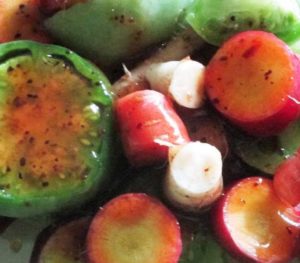
Pick green tomatoes and multi-color carrots from the garden, add balsamic vinaigrette dressing, and, voila, Joey’s Garden Garden Salad.
MY GARDEN WATERING OBSESSION: My two water barrels are pretty full, meaning I have about 50 gallons of non-house water on hand. The water is from various sources, including rainwater and recycled water from the cellar dehumidifier. But, after talking to other gardeners about watering, most recently Diane Larson, the horticulturist at the Rutgers University Cooperative Extension/Monmouth County, I am backing off on my daily watering. Instead of a daily watering, I am going to an every-other-day watering or even a less-frequent watering.
THE DRIVE-BY NATURALIST, KINGBIRD: As I walked around Saint James Cemetery, I noticed a bird I had not observed in years perched on a utility line, the eastern kingbird, “Tyrannus tyrannus.” It, too, is easily identifiable: dark head, white chin and underbelly, a white border to its dark tail. As the Cornell University All About Birds website says, “With dark gray upperparts and a neat white tip to the tail, the Eastern Kingbird looks like it’s wearing a business suit. …The scientific name ‘Tyrannus’ means ‘tyrant,’ ‘despot,’ or ‘king,’ referring to the aggression kingbirds exhibit with each other and with other species.” Here, it is a summer breeder eating insects, migrating to South America to spend winters and mainly eat fruit. An interesting fact, according to All About Birds, “Eastern Kingbirds apparently rely almost completely on insects and fruit for moisture; They are rarely seen drinking water.”
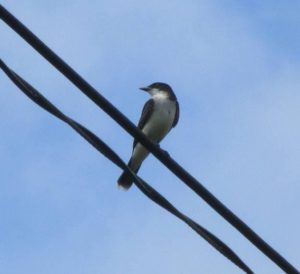
The Saint James Cemetery kingbird.
FALL CROPS: I should get carrots, lettuce, beets, and peas in the ground around August 1, although my tight schedule will probably delay that planting. Around August 15, I am looking to plant spinach.
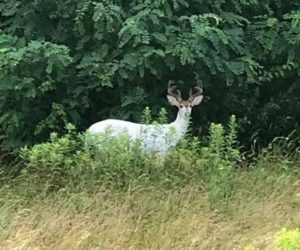
This white-tailed deer, “Odocoileus virginianus,” in a genetic piebald state lives in the Route 130 area of Cranbury, Middlesex County. Thanks to George Nikitiades, whose family owns Teddy’s luncheonette in Cranbury, for passing along this photograph.
THE DRIVE-BY NATURALIST, DEER: As I was driving to the Monmouth County Fair, I passed a soybean field in Monroe and noticed a doe with her two fawns. The good thing for me, I captured some nice photographs. As for the farmer, his or her crops are likely being shared with these deer.
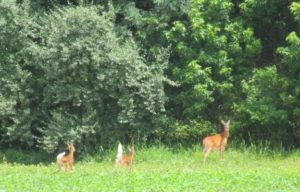
The Monroe doe and her fawns.
MONMOUTH COUNTY FAIR: The Monmouth County Fair, operated by the county Park System, completes its five-day run Sunday, July 30. This fair has a little bit of everything – and I like it because it retains the Old Jersey farm, garden, animal, and home exhibits. I spent some time there with retired county Agricultural Agent Rich Obal, county plant horticulturist Diane Larson, and Master Gardeners judging vegetables, flowers, and herbs. It was good to see Rich, whom I dealt with as an Asbury Park Press reporter over 30 years. And a shout out to Diane, who runs the Master Gardeners program, for continuing to answer my questions over the years.
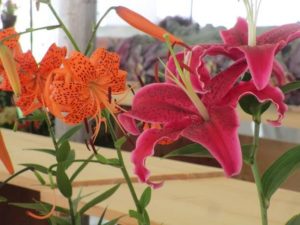
Flowers at the Monmouth County Fair.
QUEEN ANNE’S LACE: Outdoorswoman Priscilla “Peppy” Bath of Hamilton, Mercer County, noted, “The Queen Anne’s lace is outstanding this year. When I was a little kid I would put some stems of Queen Anne’s lace in ink and watch the flowers turn blue.” I, too, have noticed a lot of Queen Anne’s lace, ““Daucus carota,” this year. And, now that Peppy has given me the idea, I will have to go out and buy some food coloring.
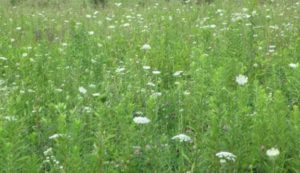
Queen Anne’s lace blooming in a fallow field at Heavenly Farms, East Brunswick, Middlesex County.
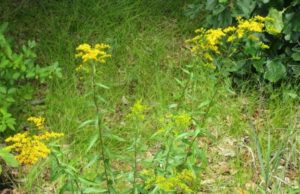
Goldenrod, genus “Solidago,” is blooming along roadsides. Here, it blooms along ConRail railroad tracks in Monroe.
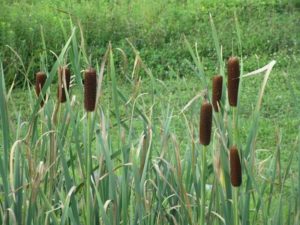
Punks, or cat-tails, genus “Typha,” are in flower in wetlands.. These were photographed at Heavenly Farms in East Brunswick, Middlesex County.
GARBAGE IN THE WOODS: Because of development, destruction caused by off-road vehicle riding, and littering or garbage dumping, we are losing the battle to protect open space. Earlier this month, I came across living room furniture dumped along an East Brunswick, Middlesex County, public road passing through the Jamesburg Park Conservation Area. Middlesex County Parks and Recreation responded and removed the trash. The Jamesburg Park Conservation Area is approximately 1,400 acres of Pine Barrens ecosystem in East Brunswick, Helmetta, Spotswood, and Monroe. It is home to one of the few Atlantic white cedar swamps in the area, along with pine-oak forest, orchids, carnivorous plants, various wildlife (including the carpenter frog, which could be at its northernmost location, here.) See http://www.middlesexcountynj.gov/…/PR/Jamesburg-Park-CA.aspx. It is truly a jewel that needs to be respected, so that future generations can enjoy it, too. I take this personally — My family through my maternal side has walked afield in what is now the conservation area for more than 100 years and I have been a volunteer at Jamesburg Park for years. If anyone recognizes this furniture and knows the owner, please report it to Parks and Recreation, telephone 732-745-3900.
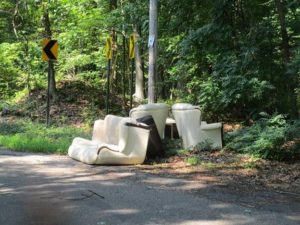
The furniture dumped at the Jamesburg Park Conservation Area.
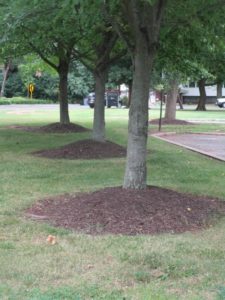
I thought this tree-mulching scene was ironic because it is on Rutgers University’s Douglass-Cook campus. Cook is where Rutgers agriculture studies are based. And these volcano-like mounds are the wrong way to mulch! Creating the volcano-look, or the pileup of mulch against a tree could cause too much wetness around the bark or make the tree susceptible to insect infestation or disease. Instead, use the “doughnut” method of placing the “doughnut hole” outside of the tree and its exposed roots, so the mulch is not touching bark. Outside of the hole, the mulch should be about only 2 or 3 inches in depth, so as not to overwet the tree. The outer rim of the “doughnut” should go to the end of the root ball or the tree canopy/drip line. If a tree is established, there is no need for mulching.

The Northeast Corridor railroad tracks bridge crossing the Raritan River between New Brunswick, left, and Highland Park, right, in Middlesex County. This photograph shows the day’s changing weather, some rain, some sunshine.
PLEIN AIR ART IN THE GARDEN: One night, I plopped myself in a chair at the edge of my garden and used color pencils to do an artwork of the zinnias, which continue to bloom beautifully.

Zinnias in the garden.
OCEAN TEMPERATURES: Atlantic Ocean temperatures on the New Jersey coast were reported at around 75 degrees on Saturday, July 29.
UPCOMING COUNTY FAIRS: Middlesex County Fair, August 7, Monday, to August 13, Sunday, in East Brunswick, http://middlesexcountyfair.com/. Somerset County 4-H Fair, August 9, Wednesday, to August 11, Friday, in Bridgewater, http://www.somersetcounty4h.org/fair/. Hunterdon County 4-H and Agricultural Fair, August 23, Wednesday, to August 27, Sunday.
SUNRISE/SUNSET: For July 30, Sunday, to August 5, Saturday, the sun will rise at about 5:55 to 6 a.m. and set about 8:10 p.m.
WEATHER: The National Weather Service forecasting station for the area is at http://www.weather.gov/phi/.
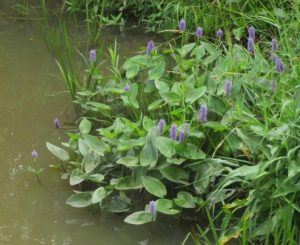
Pickerel weed, “Pontederia cordata,” in bloom on the Millstone River on the boundary of Middlesex County (Monroe and Cranbury) and Mercer County (East Windsor).
Joe Sapia, 60, is a lifelong Monroe resident. He is a Pine Barrens naturalist and an organic vegetable-fruit gardener.
He gardens the same backyard plot as did his Italian-American father, Joe Sr., and his Polish-immigrant, maternal grandmother, Annie Poznanski Onda. Both are inspirations for his food gardening. Joe is active with the Rutgers University Master Gardeners/Middlesex County program. He draws inspiration on the Pine Barrens around Helmetta from his mother, Sophie Onda Sapia, who lived her whole life in these Pines, and his Grandma Annie. Joe’s work also is at @JosephSapia on Twitter.com, along with Facebook.com on the Jersey Midlands page.
Article and photos by Joe Sapia
Note: The yard references are to my house in the section of Monroe between Helmetta and Jamesburg in South Middlesex County. My yard is in a Pine Barrens outlier on the Inner Coastal Plain, the soil is loamy, and my neighborhood is on the boundary of Gardening Zones 6b (cooler) and 7a (warmer). Afield references are to the Pine Barrens around Helmetta, unless otherwise noted. Notes and photographs are for the period covered, unless otherwise noted.
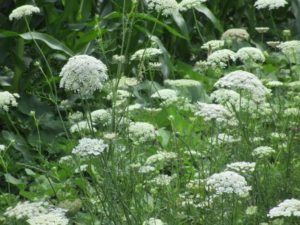
Queen Anne’s lace along a roadside in Monroe, Middlesex County.
THE DRIVE-BY NATURALIST: During the week, I noticed the white-flowered Queen Anne’s lace, “Daucus carota,” blooming along various roadsides. Also, blue-flowered chicory, “Cichorium intybus,” remains in bloom. This got me thinking, how we can observe nature as we drive by. As I try to point out, keep your eyes open – for plantlife and wildlife, along with looking up at the daytime and night skies. Nature is around us, so do not miss out on it. And keep the camera ready!
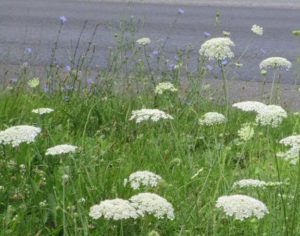
Here, Queen Anne’s lace, the white flower, and chicory, the blue flower, in bloom along a roadside.
ON MY DRIVE-BYS: Despite the warm temperatures during the week, I have been watching for the changing colors of foliage. Yes, it is only July, but the “fall” foliage changing of colors should be starting right about now in the wetlands in the Pine Barrens around Helmetta. I have not seen it yet, but I generally look for changing colors in swamps beginning somewhere in the July 15-to-July 31 period.
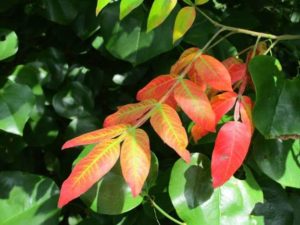
Here, leaves changing colors in 2015, late July, at Cranberry Bog in the Pine Barrens around Helmetta.
SPOTTED ON A DRIVE-BY: As I was putting together this week’s “Garden and Afield,” I shot some last-minute photographs and was driving home when I noticed some deer, “Odocoileus virginianus,” just off the road near Manalapan Brook on the Monroe-Spotswood boundary, Middlesex County. Usually when you see a fawn, Mama is nearby. On this day, though, I caught what I consider an uncommon sight, fawns and a buck (whose antlers were in velvet). Mama Deer was probably keeping an eye on the fawns from nearby in the woods.
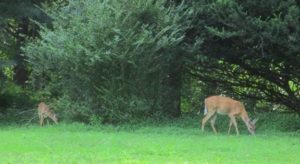
A fawn and a buck in Monroe, Middlesex County.
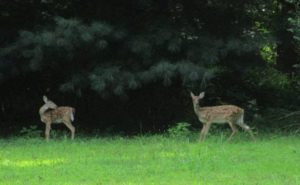
Two fawns in Monroe, Middlesex County.
LOW-MOISTURE-IN-THE-AIR BLUE SKY: Ever notice days when the sky just has that clear look to it? Based on my Roman Catholic upbringing and 16 years in Catholic schools, I call it a “Blessed Mother Blue Sky,” because the sky has the look of the blue clothing associated with the Virgin Mary. Joey Slezak, my go-to science guy in the Pine Barrens around Helmetta, calls it a “Bluebird Sky.” “The first I heard ‘Bluebird Skies’ is (when I was) skiing,” Joey said. “People talking about it. You have white (snowy) ground contrasting the blue sky.” Joey, who has a bachelor’s degree in meteorology from Rutgers University and has completed his master’s degree course work in meteorology at the university, explained the clearness translates as “low moisture” in the air.
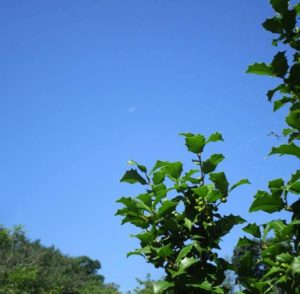
The clear blue sky is a result of low moisture in the air as the moon wanes after the July 8-9 overnight Full Thunder Moon. The next full moon is the August 7-8 overnight Full Red Moon
GARDEN ENEMIES: I have not seen the ground hog and its offspring lately, although the wood steps at one of my house doors is collapsing into their burrow. The rabbits are always around. Then, the other day, I found deer droppings and hoof prints in my garden. Finally, I found the tops of my tomato plants snipped off. Well, there goes this year’s tomato crop….
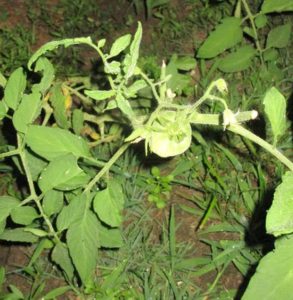
A snipped-off tomato plant in the garden.
WATERING THE GARDEN OBSESSION, NO. 1: On Sunday, July 16, for the first time since planting the food garden around May 20, I was able to water it completely by hand, using water I had accumulated in garbage can reservoirs. I used roughly 30 gallons for the 950-square-foot, or 315-row-feet garden. Now, to replenish the 20-gallon and 30-gallen barrels with rainwater, cellar de-humidifier water, water caputured while sprinkling the garden using the house system, and water from Manalapan Brook. (I keep the barrels covered so as not to promote mosquito development.)
WATERING THE GARDEN OBSESSION, NO. 2: With the water accumulated in my barrels, I thought I could cheat a little, by hooking up a simmer pump and hose to a sprinkler, rather than walking the garden with sprinkling cans. Well, I clogged the sprinkler, which required me unclogging it – but not until I gave up on using the pump for sprinkling. I guess the pump picked up gunk from the water barrel. And I am not even sure the pump was powerful enough to propel the sprinkler properly.
WATERING THE GARDEN, OBSESSION NO. 3 — MANALAPAN BROOK: I grabbed two buckets and took the walk of a few hundred feet to Manalapan Brook, the section between “Jamesburg Lake” (Lake Manalapan) and “Spotswood Lake” (DeVoe Lake). There, I was greeted by my friends, ebony jewelwing damselflies, “Calopteryx maculate.” I waded into the Brook, filled the two buckets, took some photographs, and headed home.
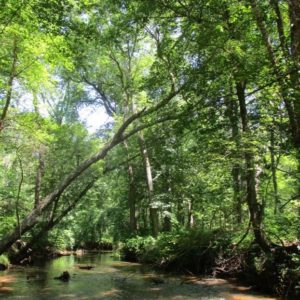
Manalapan Brook in the section of Monroe between Helmetta and Jamesburg, looking downstream toward Helmetta.
ELSEWHERE IN THE GARDEN: I am awaiting cantaloupe/mushmelon and sweet corn, both seemingly behind on the calendar from last year. The tomatillos, which I did not plant, are ready for harvesting; I will pass them along to a co-worker. Otherwise, I had some pea seeds laying around I decided to plant about a week or so ago; They are sprouting.
THE SIZE OF MY GARDEN: Friend, fellow hiker, and fellow gardener Priscilla “Peppy” Bath had an interesting observation about my garden: “Your vegetable garden is so good as you tell about it. I expected it to be much bigger. …Perhaps it would be interesting to others that you do not have one to two acres, but just a normal back yard.” Yes, my yard is only about a quarter-acre. “It would possibly encourage others to make a vegetable garden in their backyards,” Peppy said. I think people do not realize how productive a small garden could be. So, I reached out to friend Diane Larson, who is the home horticulturist and Master Gardener coordinator for the Rutgers University Extension Service office in Freehold, Monmouth County. The Monmouth County Master Gardeners garden is about 40 feet by 50 feet, or about 2,000 square feet. From 2006 to 2016, or over 11 growing seasons, the garden has produced 26,000 pounds of vegetables – an average of about 2,364 pounds per year, all donated to food pantries serving the needy. “The best part, besides all the produce going to food pantries, is that the MGs learn so much out there,” Diane said. “Some have never grown vegetables and they love it.”
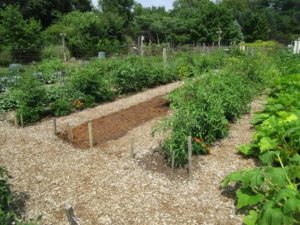
The Monmouth County Master Gardeners garden in Freehold Township. This 40-foot by 50-foot garden has averaged a yield of 2,364 pounds per year from 2006 to 2016, with all the food donated to the needy.
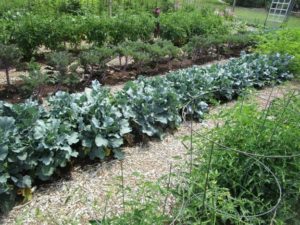
Another view of the Monmouth County Master Gardeners garden.
ZINNIA OBSESSION: My new obsessive-compulsive fascination – the zinnias I planted to attract pollinators to the food garden. For next year, I plan to dig up the front lawn and plant zinnias there, too.
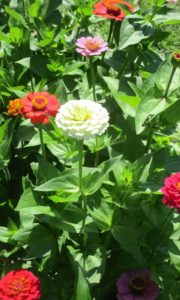
Zinnias in the garden.
FIRE IN THE MAIN PINE BARRENS: A wildfire has burned about 3,500 acres in Wharton State Forest. The fire remained burning as of Saturday, July 22. The good news is the fire — whose cause is, so far, undetermined — is not near buildings, which means the fire, too, will help keep the Pine Barrens a pine barrens. The Pine Barrens is an early succession ecosystem, so the fire – by knocking down the oaks that would shade out the pines – keeps succession in check. The pines may look like burned spars, but they are alive and can regenerate from their trunks, along with root growth and new growth of wildfire-spread seeds; The oaks, on the other hand, cannot regenerate from the trunks, but have to start all over, so to speak, by root growth. On Saturday, the fire was considered “contained,” meaning firefighters had a safe perimeter around it.
ELSEWHERE IN THE YARD: I am slowly reclaiming my yard after 4-1/2 weeks of a major remodeling project on my house – new roof, soffits, gutters and drainpipes, and siding. (For the first time since the house was built in 1952, it is no longer mint green. The retro green has been replaced by barn red.) So, I have been cutting the lawn and trimming shrubs, along with figuring how to approach my neglected garden. And I finally put up the screen tent that has been sitting in a box in my garage for a few weeks. Now, without getting bit by mosquitoes, I can spend warm nights in the screen tent reading, writing, listening to the radio, or just enjoying being outside. Next year, I plan to put the screen tent in a better location, farther from the house, closer to the garden. So, I put up the screen tent and almost immediately it began raining, then monsooning. …Oh, yes, the contractors still have a few odds and ends to finish, but I do have the yard back under my control.
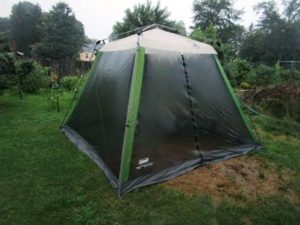
The brand-new, and rain-drenched, screen tent in my backyard.
SOURCES, BOOK NO. 1: One of my book sources is “Dictionary of Plant Names” by Allen J. Coombes, 1985 to 1989, Timber Press. I have had this book for an estimated 25 or more years and have repeatedly turned to it. It lists plants by common and scientific names, cross-referencing the two – for example, mountain laurel, “Kalmia latifolia.” It goes on, saying the genus name is from naturalist Pehr Kalm (who did work in the 1700s in the South Jersey area) and the species name translates from Latin as “broad-leaved.” Mountain laurel, according to the book, is also known as “calico bush.” I use this book both on its own and in conjunction with plant-illustration books.

“Dictionary of Plant Names” by Allen J. Coombes
TURKEY FOLLOWUP: Bob Eriksen, a retired turkey biologist of the state Department of Environmental Protection, made some observations after seeing the photograph of the wild turkeys, “Meleagris gallopavo,” in the Pine Barrens around Helmetta published in the July 9 “Garden and Afield.” Bob said, “Good to see a hen turkey with at least three poults. They are all old enough that they likely will survive to adulthood.”
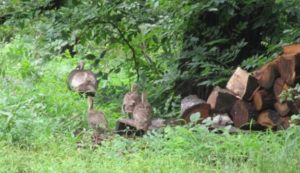
A turkey hen and her three poults in the Pine Barrens around Helmetta, specifically in the Jamesburg Park section of East Brunswick, Middlesex County.
ATLANTIC OCEAN TEMPERATURES: The ocean temperatures have run from about 70 degrees to the lower 80s. On July 18, Tuesday, Glenn “Hurricane” Schwartz, a Philadelphia television Channel 10 meteorologist, said online, “The Atlantic City ocean temperature is now up to 80 degrees. That’s practically unheard of for July. (It) peaks in August. 10 degrees above average.”
UPCOMING COUNTY FAIRS: Monmouth County Fair is July 26, Wednesday, to July 30, Sunday, in Freehold Township, https://www.monmouthcountyparks.com/page.aspx?ID=2492. Mercer County 4-H Fair, July 29, Saturday, and July 30, Sunday, in Hopewell Township, http://mercer.njaes.rutgers.edu/4h/fair/. Middlesex County Fair, August 7, Monday, to August 13, Sunday, in East Brunswick, http://middlesexcountyfair.com/. Somerset County 4-H Fair, August 9, Wednesday, to August 11, Friday, in Bridgewater, http://www.somersetcounty4h.org/fair/. Hunterdon County 4-H and Agricultural Fair, August 23, Wednesday, to August 27, Sunday.
SUNRISE/SUNSET: For July 23, Sunday, to July 29, Saturday, the sun will rise at about 5:50 a.m. and set about 8:18 p.m.
WEATHER: The National Weather Service forecasting station for the area is at http://www.weather.gov/phi/.
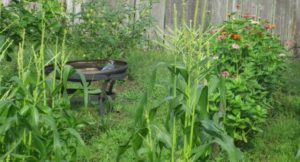
A blue jay rests in the garden, surrounded by sweet corn, tomatillos, and zinnia.
Joe Sapia, 60, is a lifelong Monroe resident. He is a Pine Barrens naturalist and an organic vegetable-fruit gardener.
He gardens the same backyard plot as did his Italian-American father, Joe Sr., and his Polish-immigrant, maternal grandmother, Annie Poznanski Onda. Both are inspirations for his food gardening. Joe is active with the Rutgers University Master Gardeners/Middlesex County program. He draws inspiration on the Pine Barrens around Helmetta from his mother, Sophie Onda Sapia, who lived her whole life in these Pines, and his Grandma Annie. Joe’s work also is at @JosephSapia on Twitter.com, along with Facebook.com on the Jersey Midlands page.
Article and photos by Joe Sapia
Note: The yard references are to my house in the section of Monroe between Helmetta and Jamesburg in South Middlesex County. My yard is in a Pine Barrens outlier on the Inner Coastal Plain, the soil is loamy, and my neighborhood is on the boundary of Gardening Zones 6b (cooler) and 7a (warmer). Afield references are to the Pine Barrens around Helmetta, unless otherwise noted. Notes and photographs are for the period covered, unless otherwise noted.
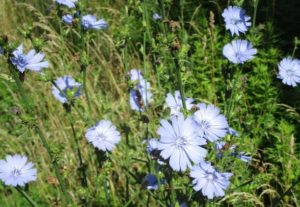
Blooming along a roadside in East Windsor, Mercer County, the beautiful, but non-native, chicory, “Cichorium intybus.”
IN THE FOOD GARDEN: I picked a cherry tomato and some carrots. Otherwise, the garden is between harvesting the early season crop of lettuce and awaiting the warmer weather crop of sweet corn, cantaloupe/mushmelon, and more tomatoes. So, come on pollination – the sweet corn has begun forming tassels (the male flower) and some silk (the female flower), while the mushmelon continues to flower in yellow.
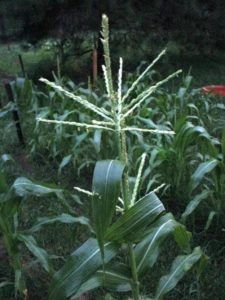
Tassels, or the male flower, on the sweet corn in the garden.
ZINNIA IN THE FOOD GARDEN: Hopefully attracting pollinators to the food garden this year are the score of blooming zinnia of orange, yellow, purple, pink, white, and rose. I have been watching more and more flowers develop this week and, in turn, various pollinators – butterflies, bees, and flies – visiting the zinnia. This is my first year using zinnia, getting the idea from watching pollinators visiting the zinnia at Bobby Laurino’s R.J. Laurino Farms in Colts Neck (www.rjlaurinofarms.com) and Andy Capelli’s Capelli Farms in Middletown (www.capellifarms.com). For next year, I plan to go zinnia-crazy, interspersing rows throughout the food garden and converting more lawn to zinnia growing.
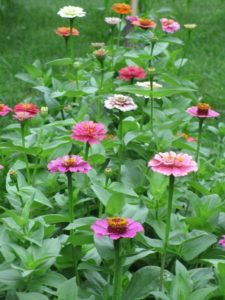
Zinnia in bloom in the garden.
FRUITING IN THE WILDS: Heads up in the wilds, blackberries, genus “Rubus,” should be fruiting here and there. Yes, they are edible – and taste great! From the New Jersey Department of Agriculture, http://www.nj.gov/agriculture/farmtoschool/documents/seasonality-chart/F2S%20Blackberries.pdf.
NEW BRUNSWICK IN FLOWER: I work part-time at Rutgers University’s Jules and Jane Plangere Writing Center at the College Avenue Campus in New Brunswick. But my parking area is cross-town, about 2 miles away at the Douglass College campus. This time of year, especially, I try to walk both ways. The walk gives me a great opportunity to photograph the city of my birth – St. Peter Hospital, Class of 1956. This week, I photographed flowers – white, light pink, dark pink, yellow, red. (Side note: For about half of my 31-year newspaper reporting career at the Asbury Park Press, Mr. Plangere was an owner. Mr. Plangere died in September at 95 years old – but he is still taking care of me!)
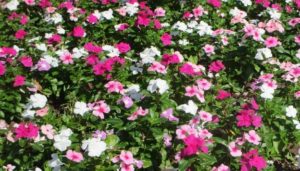
Flowering New Brunswick.
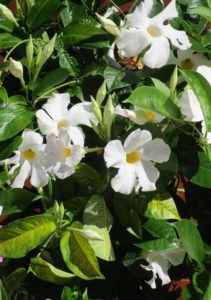
More of flowering New Brunswick.
STARLINGS: Blame these European invaders on lovers of playwright William Shakespeare! According to Cornell University’s All About Birds website, “All the European Starlings (“Sturnus vulgaris”) in North America descended from 100 birds set loose in New York’s Central Park in the early 1890s. The birds were intentionally released by a group who wanted America to have all the birds that Shakespeare ever mentioned. It took several tries, but eventually the population took off. Today, more than 200 million European Starlings range from Alaska to Mexico, and many people consider them pests.”
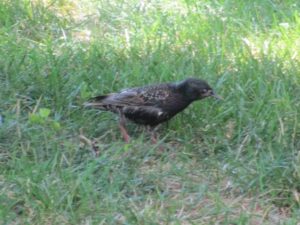
A starling on a New Brunswick lawn.
GARDEN TOOLS: As an only child, I inherited the house I grew up in, moving back to it in 2002. My parents, Joe Sapia Sr. and Sophie Onda Sapia, are the original owners of the house, dating to 1953 and my maternal grandmother, Annie Poznanski Onda, moved in with us in probably 1966. So, basically, three generations have lived here, meaning three generations of “stuff” reside here. When I moved back, I rented a 30-cubic-yard trash bin and cleaned house, except for things that were sentimental and things I figured I could use. So, today, if I need something, before I go out and buy it, I check if I have it around the house or check to see if I can rig something together from what I have around the house. This includes gardening tools. I have a shovel I use frequently and a garden claw for weeding, both with loose handles. A few days ago, I got tired of this loose-handle stuff. So, I used a technique Uncle John Onda taught me when I was a kid: place the item in water, the wood will swell, end of the loose object. I taped the claw and the shovel to the way I wanted the handles positioned, then I put them in my 20-gallon garbage can of gardening water I keep handy. About 36 hours later, I pulled them out – gardening tools that no longer have loose handles. This week, I took another shovel and am doing the same thing.
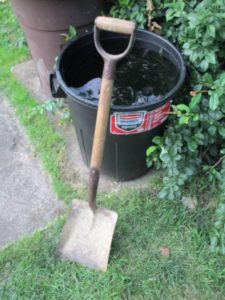
This shovel is about to be soaked in the barrel of garden water.
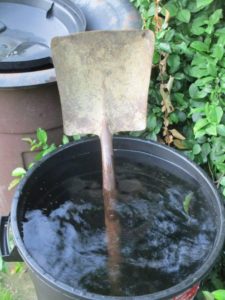
The shovel handle soaking, and swelling, in the barrel of gardening water.
OCEAN TEMPS: Atlantic Ocean water temperatures at the Jersey Shore are running at about 73 degrees to 76 degrees. The average at Sandy Hook for July 16 to 31 should be 71 degrees, according to the National Oceanic and Atmospheric Administration (NOAA).
RIP CURRENTS: This season, you may have seen various warnings of rip currents during television or radio weather reports. Rip currents – also referred to incorrectly as “rip tides” – are currents of water being returned to the ocean from the beach. A rip current dissipates within hundreds of feet, but that is enough time to sweep a swimmer out into the ocean or make it difficult for that swimmer to swim back to the beach against a rip. Basically, there are three things a swimmer can do. One, rips are relatively narrow, so the swimmer can try getting out of the rip by swimming parallel to Shore, rather than back in, until he or she is out of the rip. Two, ride out the rip and, then, swim parallel to Shore and back in. Three, float and signal for help. See NOAA’s advice, http://www.ripcurrents.noaa.gov/surviving.shtml.
WHITE ORCHID IN THE PINES: As its name suggests, the pink lady slipper orchid, “Cypripedium acaule,” generally has a pink flower. But rarely, the flower can be white. During this year’s pink lady slipper blooming season, basically late April-early May into June, outdoorsman Jay Schoss, who is a trustee of the Outdoor Club of South Jersey, found a rare white one in the Whitesbog, Burlington County, area of the Pine Barrens. I have never seen one that I can recall in my 60 years! A great find. (Thanks to outdoorswoman Faye Bray, an Outdoor Club member, for taking the photo and coming through in supplying it. The white variety was “freaking remarkable” and “absolutely beautiful,” Faye said. If you get a chance, take an OCSJ hike led by Jay or Faye. Both are great leaders and great people.)
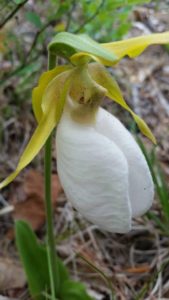
rare white flower of a pink lady-slipper orchid.
LAST WEEK’S DRAGON FLY: Roger Dreyling, a lifelong Jamesburg area outdoorsman and my cousin through marriage, identified the dragonfly I could not identify last week. It is a common whitetail, “Plathemis lydia.”
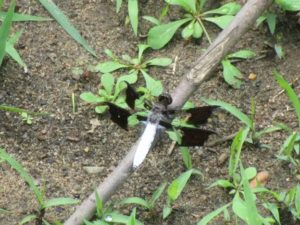
A common whitetail dragonfly in the garden earlier in July.
SUNRISE/SUNSET: For July 16, Sunday, to July 22, Saturday, the sun will rise at about 5:45 and set about 8:25 p.m.
WEATHER: The National Weather Service forecasting station for the area is at http://www.weather.gov/phi/.
NORTHERN LIGHTS: Mass ejections from an explosion at the Sun are to reach Earth Sunday, July 16, possibly enhancing viewing of the Aurora Borealis, or “Northern Lights.” The National Weather Service is saying the Northern Lights may be visible as far south as the Great Lake States and New England. Hmmmm, close enough to us to take a look into the Night Sky on the Sunday-Monday overnight.
I HAVE GOT MY YARD BACK: After almost five weeks of a house-remodeling project (altering the roofline, new roof, new siding, new gutters and drainpipes, and little things here and there), I have reclaimed my yard from the contractors – not totally, because a few odds and ends remain in the coming week or two, but generally. This means, I can get back to some very-needed yardwork – cutting the lawn, trimming the shrubs, and maintaining the garden.
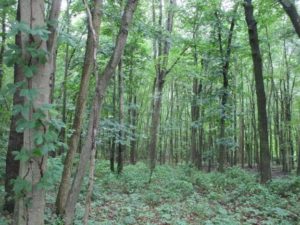
The hardwood forest at Van Dyke Farm, a combination of farm and woods in South Brunswick, Middlesex County.
Joe Sapia, 60, is a lifelong Monroe resident. He is a Pine Barrens naturalist and an organic vegetable-fruit gardener.
He gardens the same backyard plot as did his Italian-American father, Joe Sr., and his Polish-immigrant, maternal grandmother, Annie Poznanski Onda. Both are inspirations for his food gardening. Joe is active with the Rutgers University Master Gardeners/Middlesex County program. He draws inspiration on the Pine Barrens around Helmetta from his mother, Sophie Onda Sapia, who lived her whole life in these Pines, and his Grandma Annie. Joe’s work also is at @JosephSapia on Twitter.com, along with Facebook.com on the Jersey Midlands page.
Article and photos by Joe Sapia
Note: The yard references are to my house in the section of Monroe between Helmetta and Jamesburg in South Middlesex County. My yard is in a Pine Barrens outlier on the Inner Coastal Plain, the soil is loamy, and my neighborhood is on the boundary of Gardening Zones 6b (cooler) and 7a (warmer). Afield references are to the Pine Barrens around Helmetta, unless otherwise noted. Notes and photographs are for the period covered, unless otherwise noted.
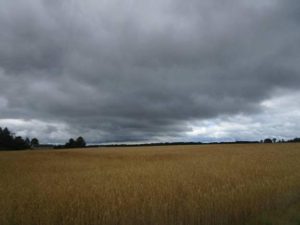
A rainy day begins to clear at a farm on Plainsboro Road in Cranbury, Middlesex County.
IN THE GARDEN: Harvesting-wise, the garden has slowed down, with the lettuce taking on a bitter taste, suggesting it is done for the cool season. I will plant more lettuce later in the summer for the fall season. Otherwise, I wait for tomatoes, corn, and cantaloupe. I do not know what happened to my cucumbers, except that I cannot find any growing. So, again, it is the three Ws: Water, Weed, and Wait. But the big discovery, or re-discovery, was the tomatillo plants growing, and fruiting, in the garden. I never planted them, but, for at least three gardening seasons, there they are. So, add them to my future harvest.
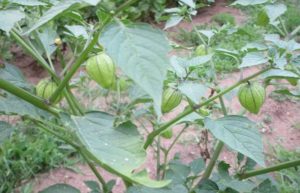
Tomatillos, which I never planted, fruiting in the garden.
AROUND THE YARD: I try to observe, whether it be looking around the yard or the sky (both night and day). As the week wrapped up and I was in the garden, I saw a red-tailed hawk, “Buteo jamaicensis,” soaring over the neighborhood. The Knock Out roses continue blooming nicely, the second bloom of the season. And I am visited by rabbits, probably “Sylvilagus floridanus,” and one of my favorites in wildlife, the catbird, “Dumetella carolinensis.” A catbird, unsure if it is the same one, keeps me company in the yard, whether I am gardening or simply hanging out.

A red-tailed hawk soaring over the neighborhood.
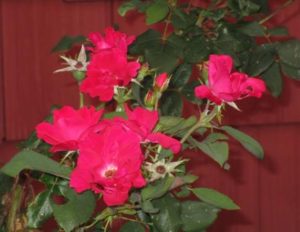
The yard’s Knock Out roses are in their second bloom of the season.
PINE BARRENS AROUND HELMETTA: Over the week, I walked afield only once and briefly. But I am around the wilds and drive paved roads through them daily. And I keep the camera at hand. I photograph a lot in a capture-the-moment way. So, I avoid using a cellphone, because it takes too long to unlock and it is too difficult to maneuver one-handed, instead using a point-and-shoot camera. I keep the camera at the ready — on the dashboard of my Jeep or, when I am doing yard work, in my pocket. Alas, this week, I was driving, I could not stop the Jeep, grab the camera, and focus the camera quickly and properly, missing a good photo of a group of turkeys, “Meleagris gallopavo,” with a deer, “Odocoileus virginianus,” in the background, around a woodpile as I drove past a house in the woods of Jamesburg Park. But I did photograph the turkeys and deer separately.
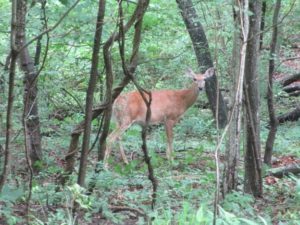
The deer in the Jamesburg Park section of East Brunswick.
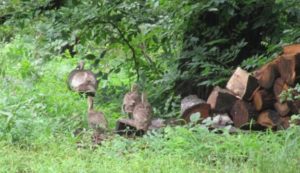
The Jamesburg Park turkeys.
WATERING THE GARDEN: I continue to obsess over watering the garden. This year, I have avoided “brown water,” or already used water such as bath water. Instead, I use freshwater, a combination of house system water, water from Manalapan Brook, captured rain water, and water from the cellar de-humidifier. I water daily, always before 10 a.m. so water is not lost to evaporation in the heat of the day and leaving the day for the plants and soil to dry, keeping fungus away. Now, I am considering watering fewer times a week, but in heavier doses. Friend, gardener, and environmental scientist Virginia Lamb had these thoughts, “I only water maybe twice a week and directly on plants, individual or rows. Probably roughly 2 quarts per plant. … Also you need to add mulching to your list of three Ws. …It will help retain moisture and keep weeds down. Also, add compost to the soil.”
EBONY JEWELWING AT THE BROOK: Manalapan Brook, which my family through my maternal side has lived along more than 100 years, runs about 400 feet from my front door. I regularly take a walk across the street and head to the Brook at the edge of the woods. This week, I encountered one of my favorite wildlife species, the ebony jewelwing damselfly, “Calopteryx maculate” – a beautiful combination of neon green and deep black. Two were flying around. I was hoping at least one would land on my outstretched arm, but not on this day. Eventually, I grabbed a bucket of water for my garden and went back home.
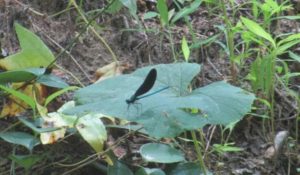
An ebony jewelwing rests along the bank of Manalapan Brook.
DAMSELFLY OR DRAGONFLY: When I was visiting Manalapan Brook, I also saw a dragonfly. What kind? I do not know. But I knew it was a dragonfly because at rest, its wings were like those of an airplane, parallel to the ground. A damselfly rests with its wings perpendicular to the ground.
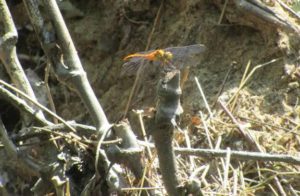
A dragonfly on the bank of Manalapan Brook.
SPOTSWOOD LAKE: Spotswood Lake, also known as DeVoe Lake or Mill Lake, is formed by the damming of Manalapan Brook. I happened to be at Spotswood Lake this week when the moon rose above it early in the night. So, there was a nice combination of the moon and soft sunlight.

The moon over Spotswood Lake.
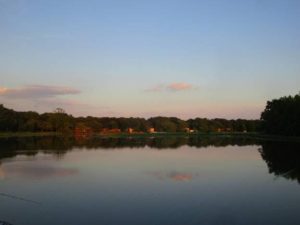
Soft sunlight on Spotswood Lake.
BALD EAGLES: I saw a Facebook report of a bald eagle, “Haliaeetus leucocephalus,” on road kill in Jamesburg. Debbie Sullivan Farrell reported, “Did anyone else see the eagle by the rescue squad at 9:50 this morning? I turned onto Gatzmer from Hillside and was going towards the tracks. An eagle was checking out some road kill and flew off towards the firehouse. It was huge!!! Then I saw the unmistakable white head. It was about 20 feet from me. It was an amazing sight.” The state Department of Environmental Protection 2016 bald eagle nest summary, http://www.conservewildlifenj.org/downloads/cwnj_736.pdf. Bald eagles are “endangered” (in immediate peril) as breeders and “threatened” (could become endangered if conditions persist) as non-breeders. In 1982, there was only one bald eagle nest in New Jersey; Last year, there were about 150.
GROVERS MILL: Does the name of this village in West Windsor, Mercer County, sound familiar. Well, it was the site of the Martian landing in the 1938 radio play adaptation -– by Orson Welles and the Mercury Theatre on the Air — of H.G. Wells’s novel, “The War of the Worlds.” Here is the broadcast that scared the country, https://www.youtube.com/watch?v=Xs0K4ApWl4g. Here is the story of the “panic broadcast,” http://www.smithsonianmag.com/history/infamous-war-worlds-radio-broadcast-was-magnificent-fluke-180955180/.

A view of Grovers Mill Pond from the spillway. The Pond is formed by the damming of Bear Brook.
RECORD GARDEN THOUGHTS: As I work the garden, I have thoughts on how I can improve it in 2018. I likely will not simply remember these ideas, so I am writing them down – things such as rotating crops, keeping only a lawnmower’s width between rows, maybe doing less space between plantings, and so on.
“FALL FOLIAGE” IN THE PINE BARRENS: Summer lovers, you probably do not want to hear about colder weather coming. But those of you venturing into the Pine Barrens, start looking for the changing colors of leaves in the swamps – up here in the Pine Barrens around Helmetta, roughly between July 15 and 31; maybe a week or two later in the main Pine Barrens to the south.
SEX!!!: Last week’s photo of the man turtle loving the woman turtle seems to have recharged the batteries of some readers of Garden and Afield. One woman emailed, “Love that perched turtle.” But this is my favorite e-mail exchange:
“You men love to watch herpetological porn!,” she said. “I’ve seen more pictures of snakes and turtles mating. LOL. Goes across species boundaries.”
“Baptist girls know about herp porn????” I replied.
“I do not seek out frog, turtle or snake porn!” – a likely story.
“It arrives on my desk via studies on sites like the Stafford Business Park, where the native northern pine snakes there were monitored for seven years via radio telemetry,” she continued. “The largest amount of notes was always on how much each individual male scored each season with which female. LOL. Pages and pages and pages of data and photos.”
Uh, she is an environmental scientist who studies herpetological pornography for a living….
SUNRISE/SUNSET: For July 9, Sunday, to July 15, Saturday, the sun will rise at about 5:35 a.m. to 5:40 a.m. and set about 8:25 to 8:30 p.m.
WEATHER: The National Weather Service forecasting station for the area is at http://www.weather.gov/phi/.
CORRECTION/CLARIFICATION: In the 2017, June 4 to 17, issue of Garden and Afield, I referred to a rabbit in the yard. I, likely, had the wrong scientific name. The correct scientific name probably is “Sylvilagus floridanus,” the eastern cottontail.
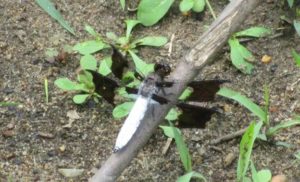
Some kind of dragonfly in the garden.
Joe Sapia, 60, is a lifelong Monroe resident. He is a Pine Barrens naturalist and an organic vegetable-fruit gardener.
He gardens the same backyard plot as did his Italian-American father, Joe Sr., and his Polish-immigrant, maternal grandmother, Annie Poznanski Onda. Both are inspirations for his food gardening. Joe is active with the Rutgers University Master Gardeners/Middlesex County program. He draws inspiration on the Pine Barrens around Helmetta from his mother, Sophie Onda Sapia, who lived her whole life in these Pines, and his Grandma Annie. Joe’s work also is at @JosephSapia on Twitter.com, along with Facebook.com on the Jersey Midlands page.
Article and photos by Joe Sapia
Note: The yard references are to my house in the section of Monroe between Helmetta and Jamesburg in South Middlesex County. My yard is in a Pine Barrens outlier on the Inner Coastal Plain, the soil is loamy, and my neighborhood is on the boundary of Gardening Zones 6b (cooler) and 7a (warmer). Afield references are to the Pine Barrens around Helmetta, unless otherwise noted. Notes and photographs are for the period covered, unless otherwise noted.
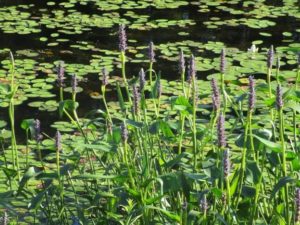
Pickerel weed flowering in Helmetta Pond.
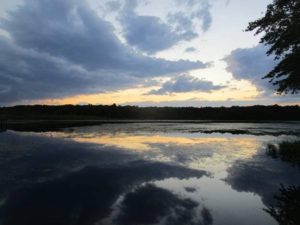
Sunset at Helmetta Pond.
TURTLES: I am still hearing a lot of talk about people coming across turtles, including misidentifying box turtles, “Terrapene carolina Carolina,” as water turtles. While a box turtle will go into water, it is generally a land turtle. So, if it is necessary to move a turtle for its safety, simply move it in the direction it is traveling. In recent days, Garden and Afield reader Bill McGovern came across two box turtles in his yard in Brick, Ocean County, and he reported, “Of course, I didn’t disturb the moment!” But he did supply a photograph of the mating turtles.
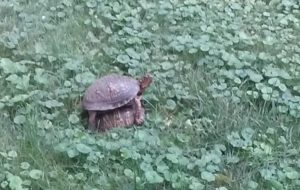
Mating box turtles in Bill McGovern’s front yard in Brick, Ocean County. An easy way to identify the gender of box turtles is by their plastrons, or underside. A female’s is flat. A male’s is concave, so he can ride the female in mating, as shown in the photo.
BLUEBERRIES: Sophie Majka, a long-time neighbor of my family in the Pine Barrens around Helmetta, told me a little bit of local lore: Blueberries are ready to pick on St. John’s Day.
Saturday, June 24, was St. John the Baptist Day. So, a few days later, I did a quick check of the woods and found a few berries — actually, probably black huckleberry, “Gaylussacia baccata.” A few ripened blue, most still green. Based on reports I have been seeing from the main Pine Barrens to the south, they have been ripe there for several days. The berries will be around for the upcoming weeks.
Black huckleberry — along with low-shrub blueberries of the genus “Vaccinium” — are found on the uplands as the shrub understory of the forest. In the fall, these low-shrub berry plants are easy to identify because they turn flame red with the changing of “fall foliage” colors.
For those more daring, head to the swamps for taller blueberry bushes of the genus “Vaccinium.”
Just a note: Wild blueberries are not commercially cultivated berries, so they are smaller.
A few years ago, Mrs. Majka and I spent some time up Jamesburg Park, picking the low-shrub blueberries. Mrs. Majka died at 92-years-old in March. This week, in the area where she and I picked, berries were ripening, providing a nice memory of Mrs. Majka.
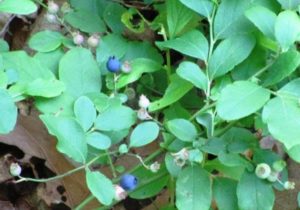
“Blueberries,” probably black huckleberries, at Jamesburg Park.
IN THE GARDEN: I am harvesting carrots, but not to the extent I thought I would. Lettuce has taken on a bitter taste, so I stopped harvesting that. Cantaloupe and zinnia plants are flowering. Also watching tomato, cucumber, and sweet corn grow. Aside from harvesting carrots, I am back to the three Ws: Weed, Water, and Wait.
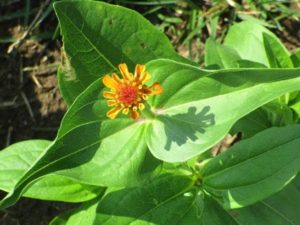
Zinnia, with which I hope to attract pollinators for the food plants, beginning to bloom in the garden.
GARDENING KNOW-HOW: I use various sources to learn about my food gardening: my colleagues at the Rutgers University Cooperative Extension/Middlesex County Master Gardening program, other gardeners, farmers, farm-garden shows and articles. In her column this week in the Philadelphia Inquirer newspaper, Sally McCabe talked about gardening deadlines associated with the Fourth of July, including it being the last time of the season to plant tomatoes. I had already planted tomato by seed and plant, but with the early lettuce done, I had gardening space to spare. After Sally’s column, I happened to be near one of my favorite gardening centers, Tony’s Farm and Garden Center in Windsor, Mercer County. At Tony’s, I picked up 12 plants in six varieties of Chef Jeff’s tomatoes. And following grandson Tony Ciaccio’s advice, I got them in the ground immediately.
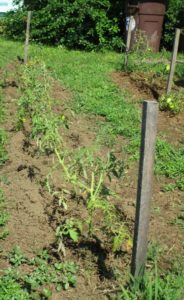
A last planting of tomatoes – various Chef Jeff’s brand – in the garden.
WATERING THE GARDEN: I water the garden daily, giving it a good soaking before 10 a.m. I either use hose-and-sprinkler, tapping house water, or I use a sprinkling can, using mostly rain, recycled cellar dehumidifier water, or recycled water from my sprinkling. When I use the hose-sprinkler system, I aim for 20 minutes; When I use the sprinkling can, I probably would use about 30 gallons to cover my entire garden of approximately 315 row-feet, or about 950 square feet. But, now, I am re-thinking this – Perhaps, I should go to a more soaking sprinkling, but fewer times a week. Thoughts?
AROUND THE YARD: Knock Out roses are starting to bloom for a second time this season.
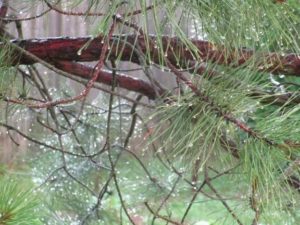
Rain clinging to a pitch pine, “Pinus rigida,” in my backyard.
FEEDING BIRDS IN THE YARD: This summer, I am trying something different – essentially not feeding birds, except with the finch feeder. I am keeping the finch feeder because I love the colorful males of the state bird, the eastern goldfinch, “Spinus tristis.” The idea of not feeding this summer is to let the birds enjoy my yard, with the three birdbaths I keep filled, and help me by eating insects. Birds, nature’s pesticide! Of course, not buying expensive bird seed saves money. However, I still have seed in a garbage pail in the garage. When I am home, I usually have the garage door open and, of course, the squirrels, “Sciurus carolinensis,” have discovered the garbage pail. Clang! That is the sound of the squirrels knocking something down as they open the garbage pail.
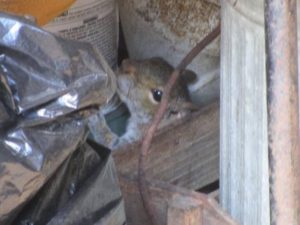
A birdseed thief trying to hide in the garage.
PEDDIE LAKE: Peddie Lake, created by the damming of Rocky Brook, is approximately 15 acres in Hightstown, Mercer County. Rocky Brook is a tributary of the Millstone River, part of the Raritan River-Bay watershed.
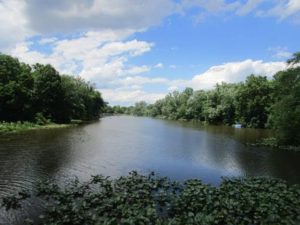
Peddie Lake
NIGHT SKY: After the Saturday, July 1, storms, the night sky was clear around 10 p.m., offering a southwest view of the half moon, the bright planet Jupiter to the lower right, and the star Spica to the lower left. The moon is waxing to the Full Thunder Moon on the July 8-9, Saturday-Sunday, overnight. Jupiter is the largest of our solar system’s eight confirmed planets. It is in orbit on the other side of Mars from Earth. Earth is in the third orbit, Mars in the fourth, and Jupiter in the fifth. Jupiter ranges 365 million miles to 601 million miles from Earth. Spica is the 16th brightest star seen from Earth. It is 260 light-years away — that is, about 186,000 miles per second over 260 years.

The moon with Jupiter to the right and Spica to the left.
SUNRISE/SUNSET: For July 2, Sunday, to July 8, Saturday, the sun will rise at about 5:35 a.m. and set about 8:30 p.m.
WEATHER: The National Weather Service forecasting station for the area is at http://www.weather.gov/phi/.
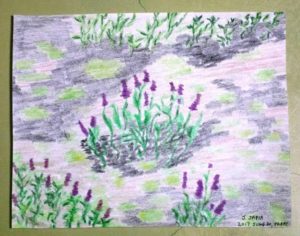
“Pickerel Weed in Bloom at Helmetta Pond,” plein air, colored pencils.
Joe Sapia, 60, is a lifelong Monroe resident. He is a Pine Barrens naturalist and an organic vegetable-fruit gardener.
He gardens the same backyard plot as did his Italian-American father, Joe Sr., and his Polish-immigrant, maternal grandmother, Annie Poznanski Onda. Both are inspirations for his food gardening. Joe is active with the Rutgers University Master Gardeners/Middlesex County program. He draws inspiration on the Pine Barrens around Helmetta from his mother, Sophie Onda Sapia, who lived her whole life in these Pines, and his Grandma Annie.
Joe’s work also is at @JosephSapia on Twitter.com, along with Facebook.com on the Jersey Midlands page.
Article and photos by Joe Sapia
Note: The yard references are to my house in the section of Monroe between Helmetta and Jamesburg in South Middlesex County. My yard is in a Pine Barrens outlier on the Inner Coastal Plain, the soil is loamy, and my neighborhood is on the boundary of Gardening Zones 6b (cooler) and 7a (warmer). Afield references are to the Pine Barrens around Helmetta, unless otherwise noted. Notes and photographs are for the period covered, unless otherwise noted.
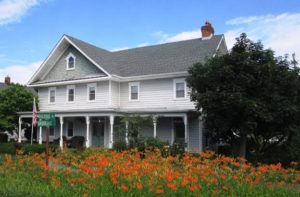
Daylilies flower in front of the former Avon Inn in Helmetta.
FLOWERING OF HELMETTA’S AVON INN: The former Avon Inn in Helmetta comes to flowering life this time of year. Now a private residence, it dates back as a circa late 1800s-early 1900s inn positioned near a railroad station. (Think of the hotel on the 1963-1970 television sitcom “Petticoat Junction.”) The Avon Inn sits at on the corner of Railroad Avenue and Brookside Place (or across from the Helmetta Post Office). It is part of the George W. Helme Snuff Mill District, named to the state and federal Registers of Historic Places in 1980.
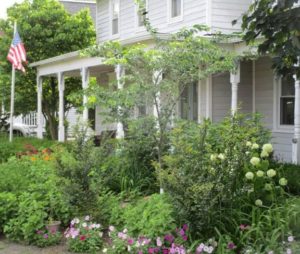
Another view of the former Avon Inn.
“OUTHOUSE LILIES”: Wild daylilies are blooming along roadsides. As their Greek scientific name “Hemerocallis fulva” suggests, “Day beauty” and “tawny” in color. Beautiful? Yes. A weed? Yes. They threaten native plants and are hard to control. It is an Asian species now naturalized locally. It was introduced to the United States as an ornamental, according to the National Park Service. In the days of outhouses, people planted daylilies around them. (Today’s ornamental daylilies began blooming earlier.)
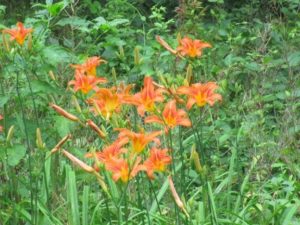
Wild daylilies growing on North Main Street in Cranbury, Middlesex County.
FRAGRANT WATER LILIES ON HELMETTA POND: At this time of year, a floral display explodes on Helmetta Pond. Fragrant water lilies, “Nymphaea odorata,” simply dot the Pond. The flower, which blooms from about June to September, is beautiful. It has a multitude of white (or pinkish) petals and a sunflower-looking yellow stigmatic bowl. The blossom has a fresh and flowery scent. Also in bloom at the Pond is pickerel weed, “”Pontederia cordata.”
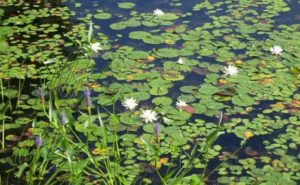
White-colored fragrant water lilies and purple-colored pickerel weed at Helmetta Pond.
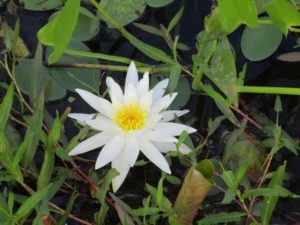
A close-up of a fragrant water lily at Helmetta Pond.
AMPHIBIANS AND REPTILES: I helped a painted turtle, “Chrysemys picta picta,” as it was crossing a road at the Helmetta Pond swamp. I moved the painter in the direction it was traveling. When I got home after moving the turtle, I did yardwork and came across Fowler’s toads, “Anaxyrus fowleri.”
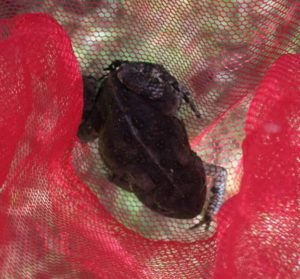
I netted this Fowler’s toad in my yard to study him for a few seconds.
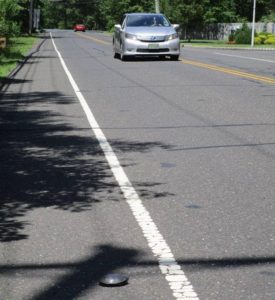
A painted turtle crossing a road at the Helmetta Pond wetlands. As I was shooting the photograph to give perspective on traffic, the car pulled over. The driver was neighbor and Garden and Afield reader Tom DeRose.
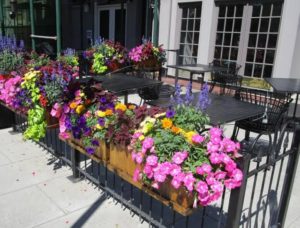
Flower display at Catherine Lombardi restaurant in New Brunswick, Middlesex County.
FLOWERING NEW BRUNSWICK: I work part-time at the Jules and Jane Plangere Writing Center on the College Avenue campus of Rutgers University in New Brunswick, Middlesex County. Because I park my Jeep at the other side of the downtown near the Douglass campus, I often walk cross-town to and from Plangere. This time of year, I pass flowers beautifully on display at the Catherine Lombardi restaurant at the corner of Livingston Avenue and George Street.

Flower display at Catherine Lombardi restaurant.
GOLDFINCH IN PEPPY’S GARDEN: Gardener Priscilla “Peppy” Bath of Hamilton, Mercer County, reported, “Saw something interesting the other day. I have columbine plants in the yard that seed themselves so they are easy to grow. I cut some of the high stems with seed when I get around to it. I saw a goldfinch (“Spinus tristis”) holding on to the main stem and eating the seeds. I did not think the stem would be strong enough but guess the bird does not weigh much. Nice. Glad I did not cut all the seeds from all the plants.”
IN THE GARDEN: A shout out to Lake Valley Seed’s “Salad Bowl Heirloom Lettuce.” I planted it April 8 and have been harvesting it in earnest – and getting rave reviews from people I have given it to. I, too, offer a positive review. On the down side, my snap peas bombed and my kaleidoscope carrots are growing slowly; Both were planted April 8. In summary, I continue to water, weed, and watch, along with harvesting the lettuce.
IN THE PINE BARRENS AROUND HELMETTA: Striped wintergreen, “Chimaphila maculate,” is in bud. Also, this is the time of year, the woods are lush and humid with pine flies, genus “Chrysops,” buzzing around a person in numbers. Because of the harsh conditions in the woods this time of year, I would shut down my woods walking – and that was probably why I recall seeing striped wintergreen in full bloom perhaps only once in my life. But, in recent years, I have taken a new approach – or, actually, an old approach dating back to childhood – and that is tough it out and enjoy the summer woods, along with the woods during the other three seasons.
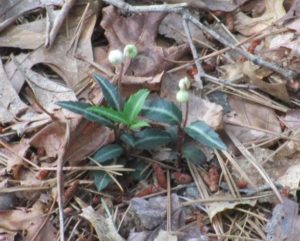
Striped wintergreen in bud in the Jamesburg Park section of East Brunswick, Middlesex County.
RAINBOW AND SUNSET: The night of Monday, June 19, provided a beautiful sky at sunset – in the sunset itself and with a rainbow. I watched it all from my yard.
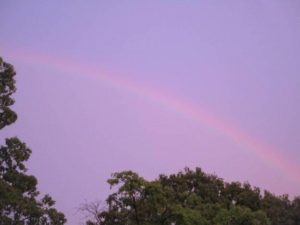
Looking east, the June 19 rainbow over the Manalapan Brook floodplain.
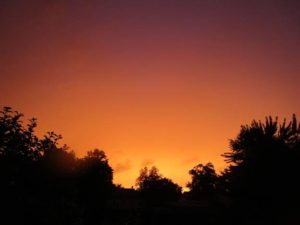
The June 19 sunset.
SUNRISE/SUNSET: For June 25, Sunday, to July 1, Saturday, the sun will rise at about 5:25 a.m. and set about 8:30 p.m.
WEATHER: The National Weather Service forecasting station for the area is at http://www.weather.gov/phi/.
THE DESTRUCTION OF THE MIDLANDS: As much as environmental conditions have improved in many ways in my lifetime, something we have not kept up with is preservation of open space. When I see the destruction of open space, especially when heavy machinery mows down the woods in only hours, I feel sad. I drove by a site the other day in South Brunswick, Middlesex County, where the woods was being torn down.

The corner of Route 130 and Fresh Ponds Road was woods only a few days ago.
Joe Sapia, 60, is a lifelong Monroe resident. He is a Pine Barrens naturalist and an organic vegetable-fruit gardener. He gardens the same backyard plot as did his Italian-American father, Joe Sr., and his Polish-immigrant, maternal grandmother, Annie Poznanski Onda. Both are inspirations for his food gardening. Joe is active with the Rutgers University Master Gardeners/Middlesex County program.
He draws inspiration on the Pine Barrens around Helmetta from his mother, Sophie Onda Sapia, who lived her whole life in these Pines, and his Grandma Annie. Joe’s work also is at @JosephSapia on Twitter.com, along with Facebook.com on the Jersey Midlands page.
 A black gum, “Nyssa sylvattica,” changes color at Cranberry Bog in the Pine Barrens around Helmetta.
A black gum, “Nyssa sylvattica,” changes color at Cranberry Bog in the Pine Barrens around Helmetta.

















































































































































